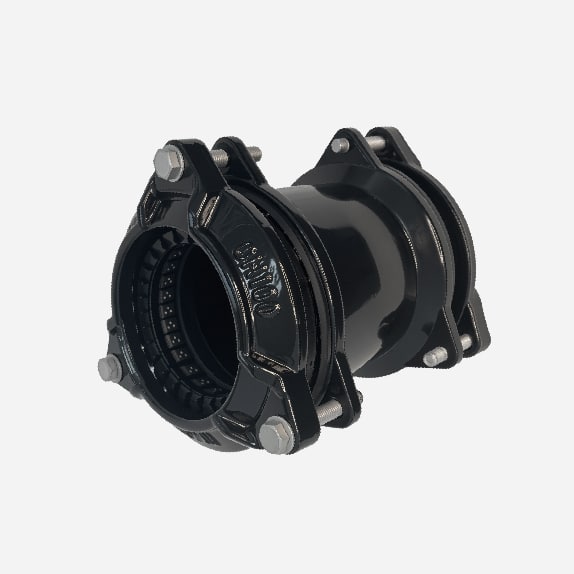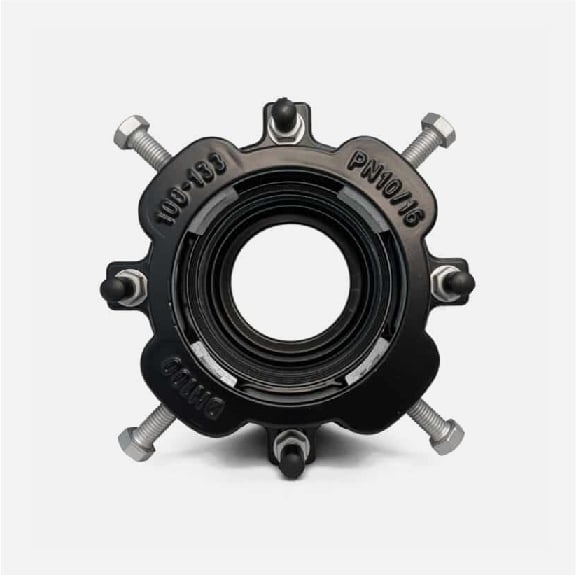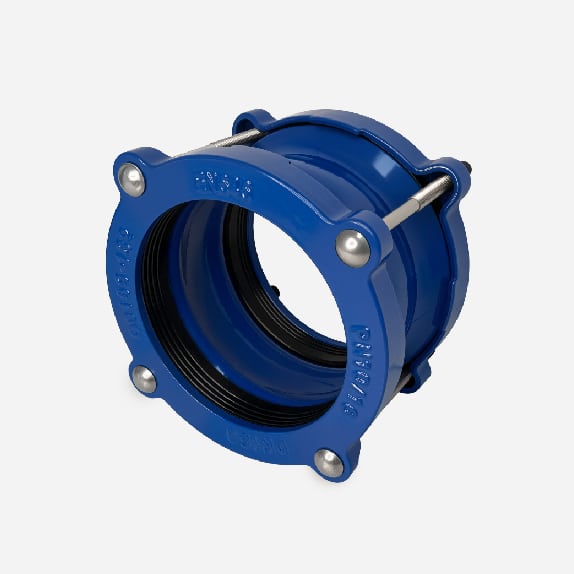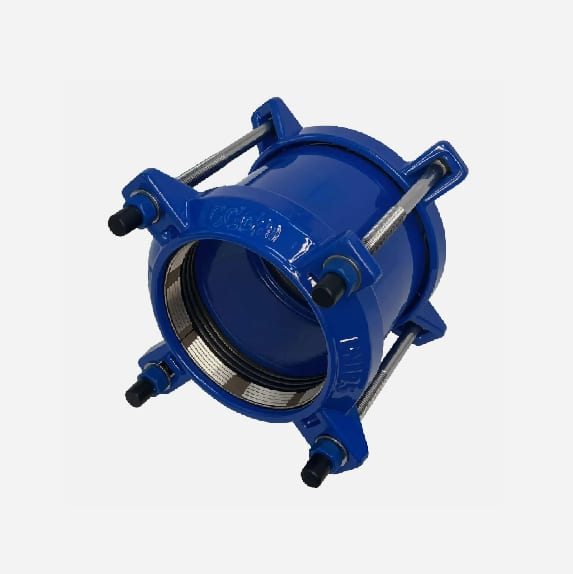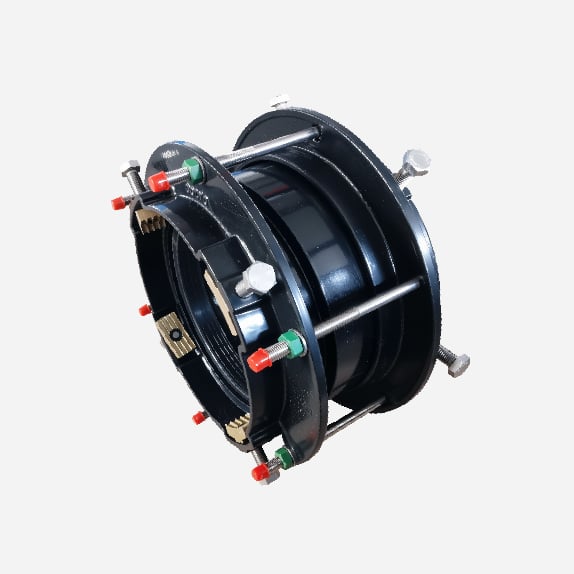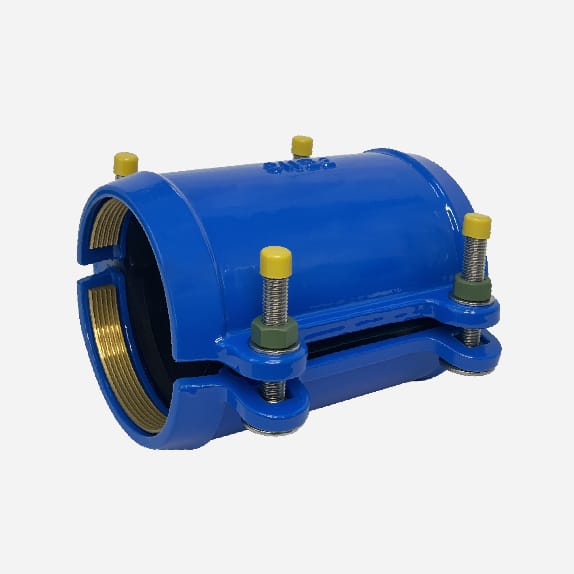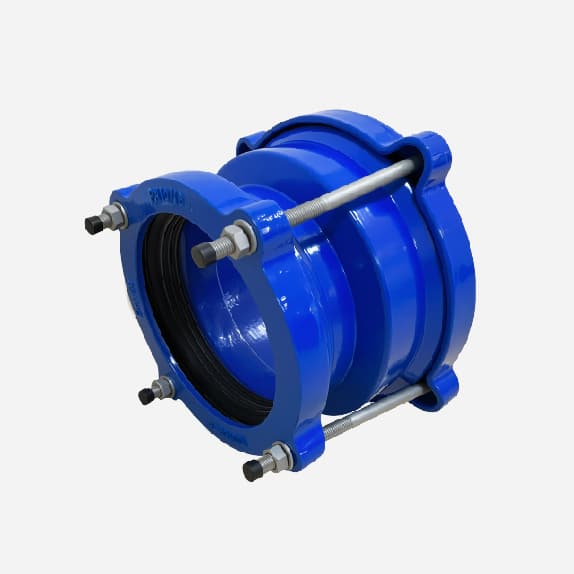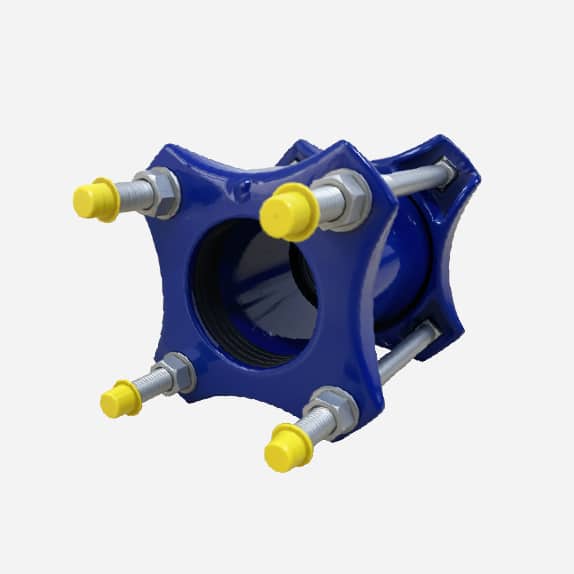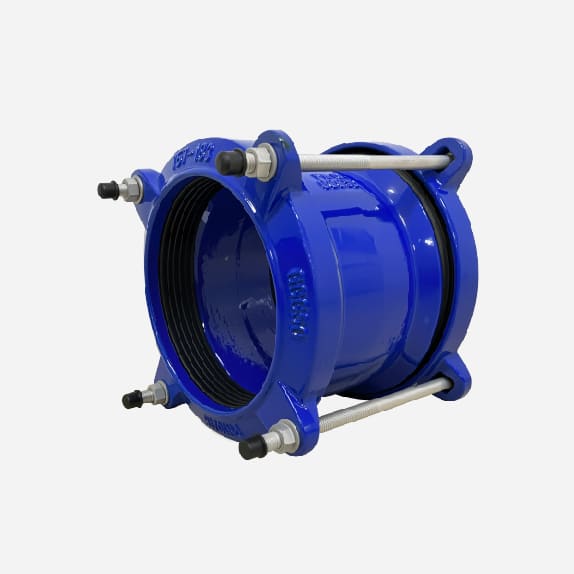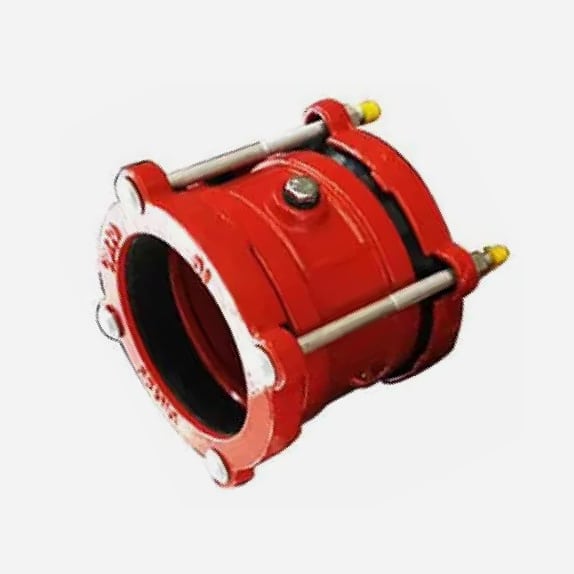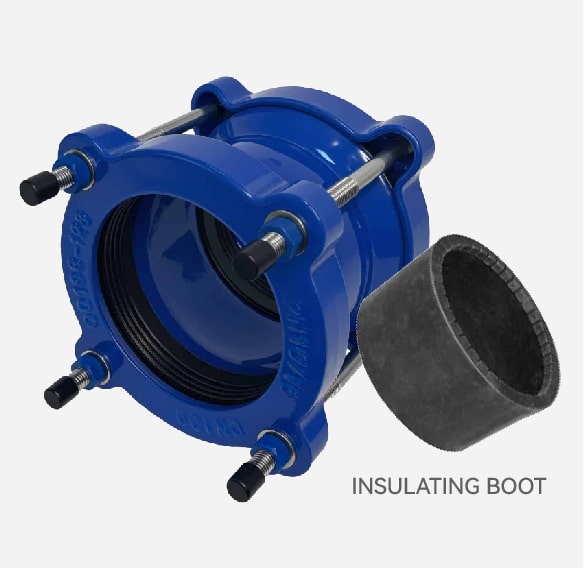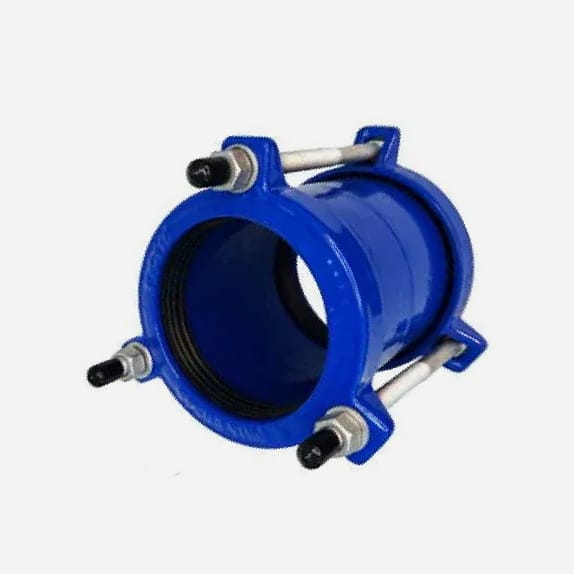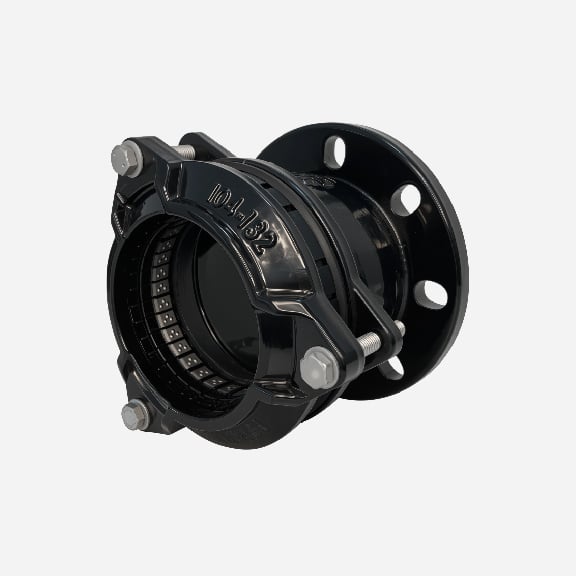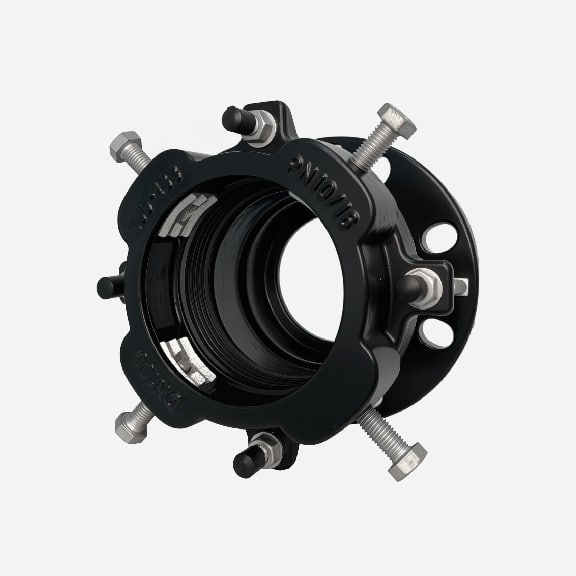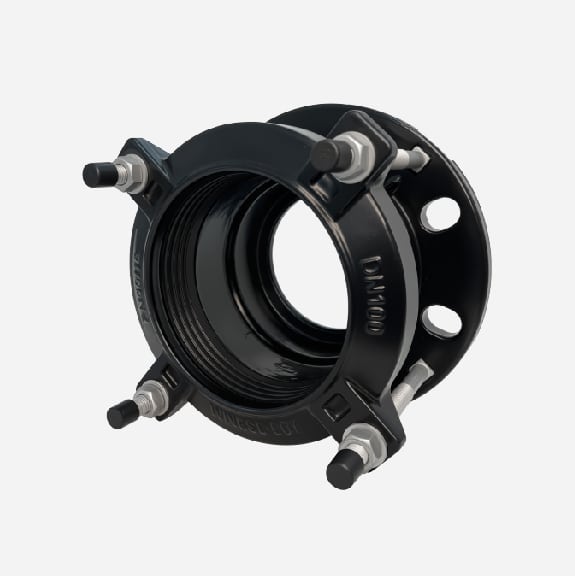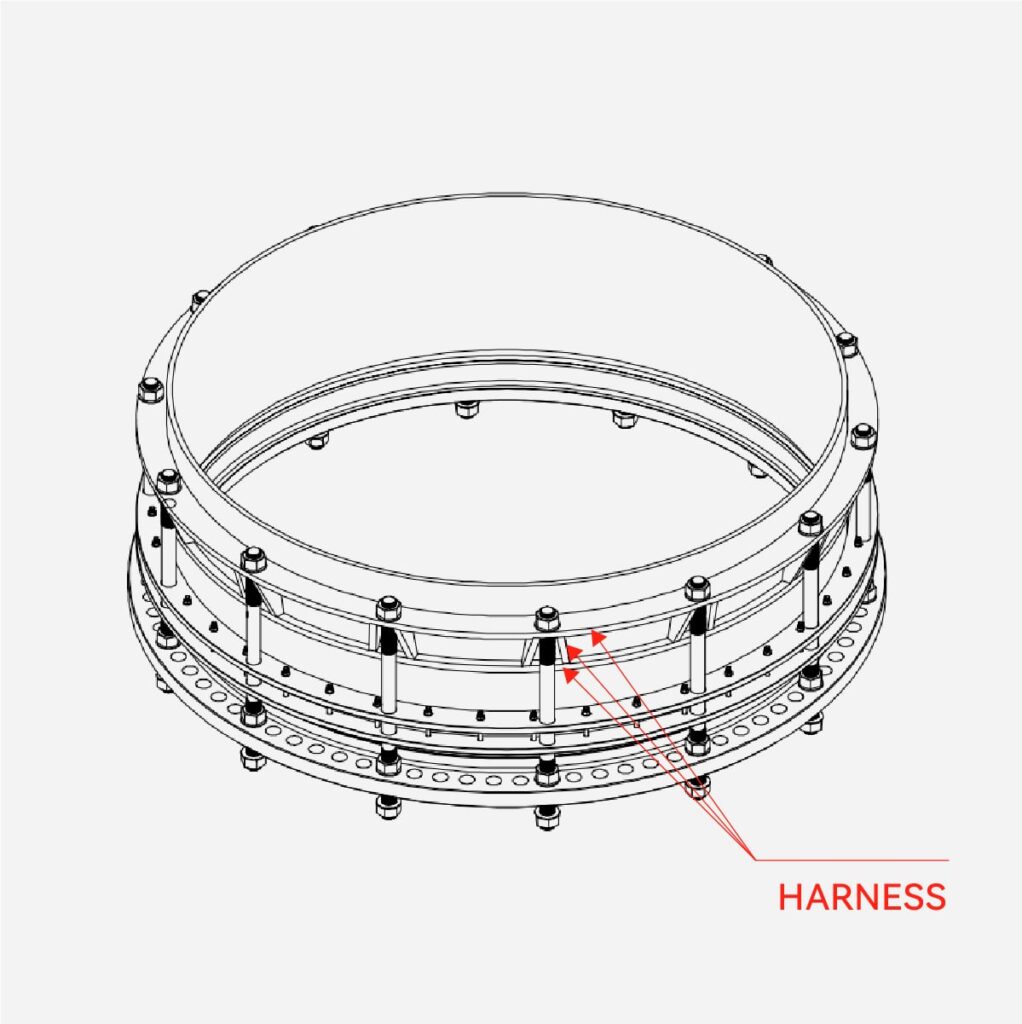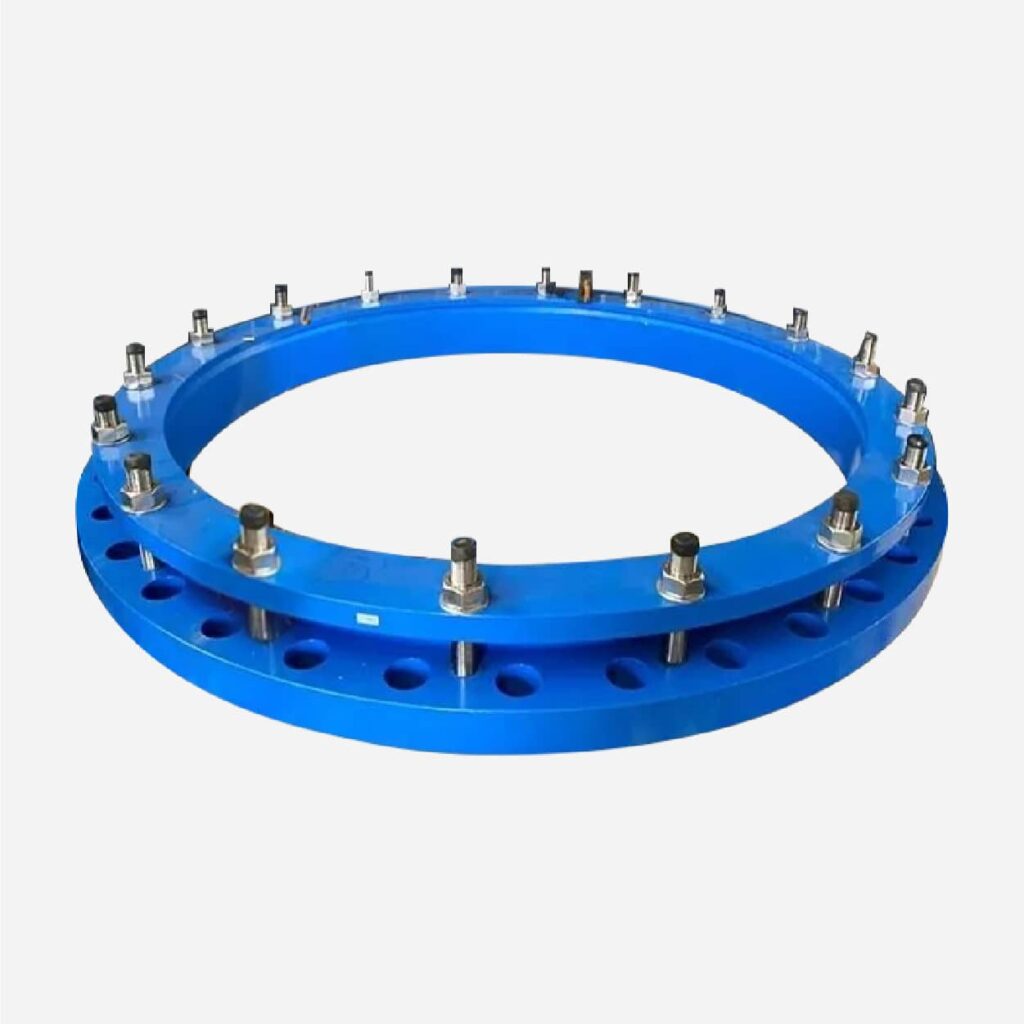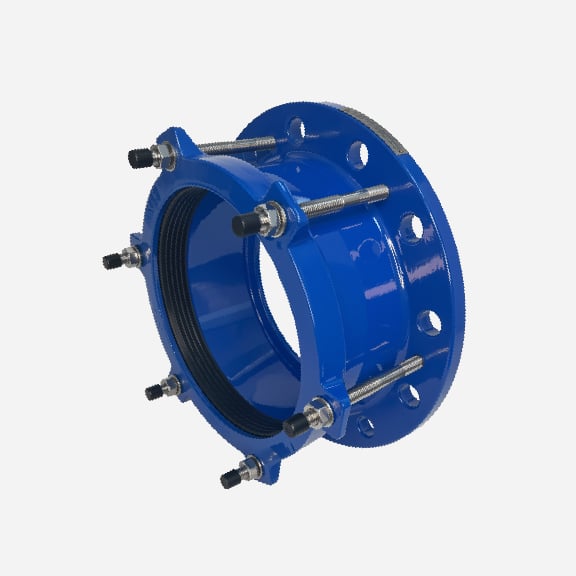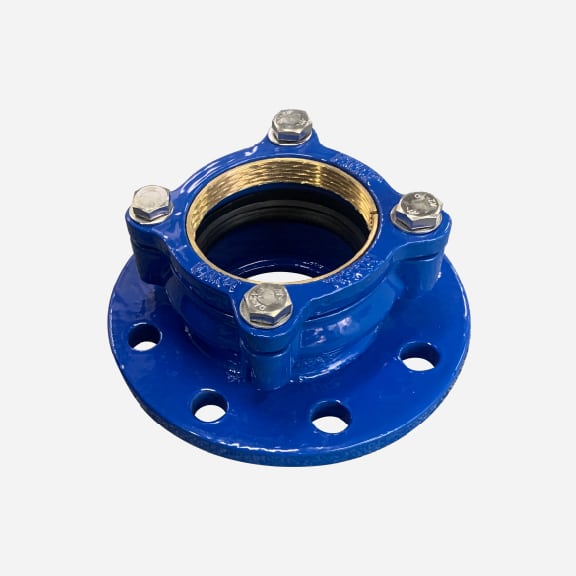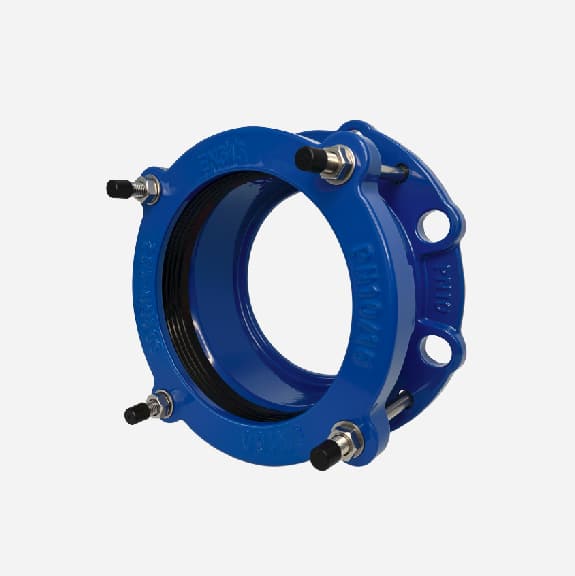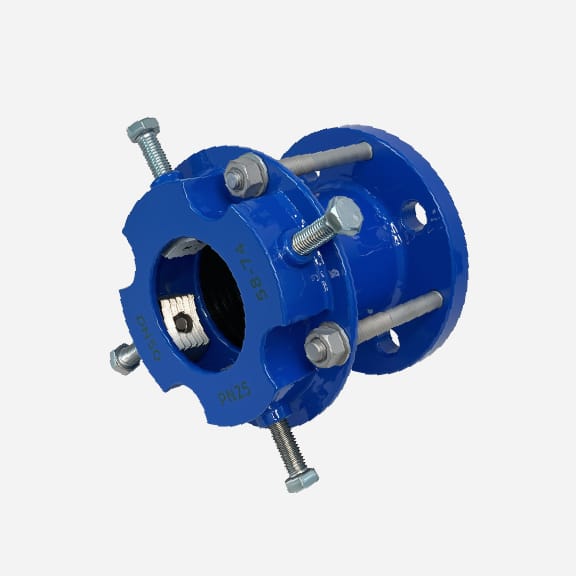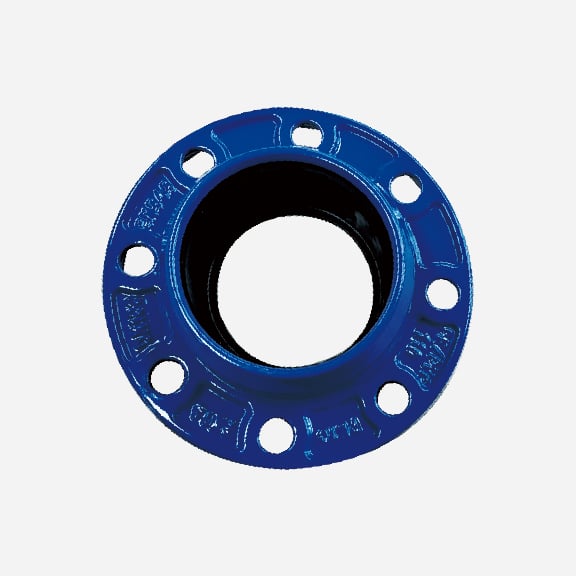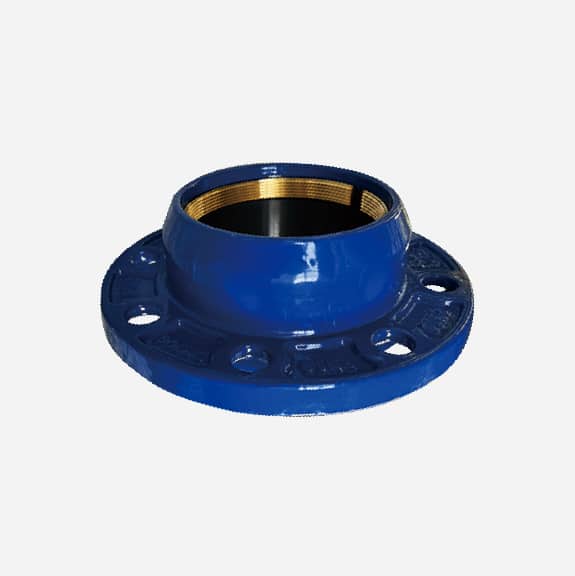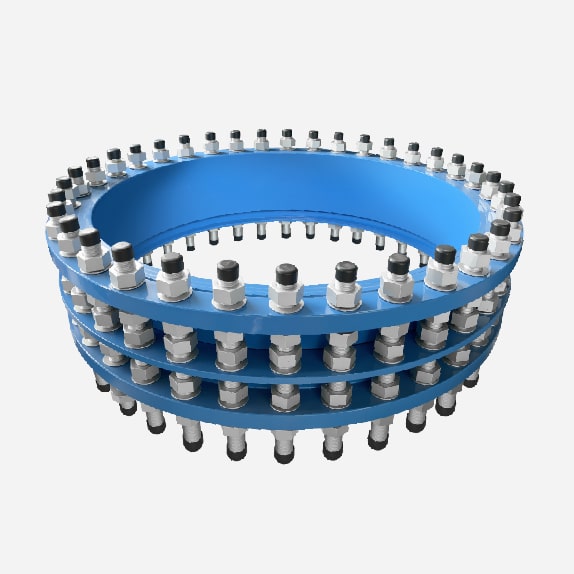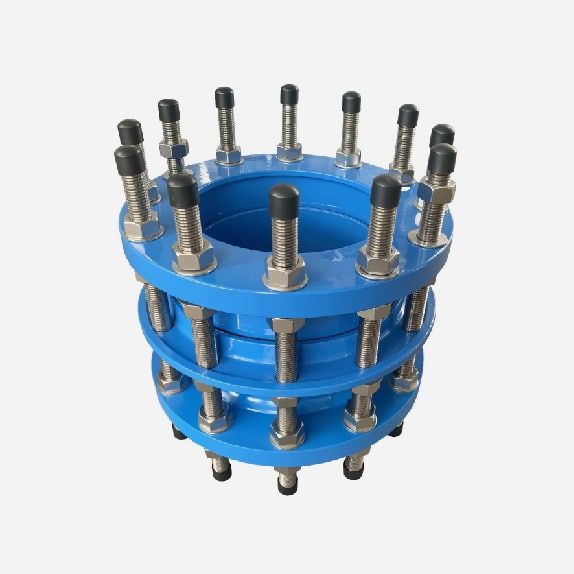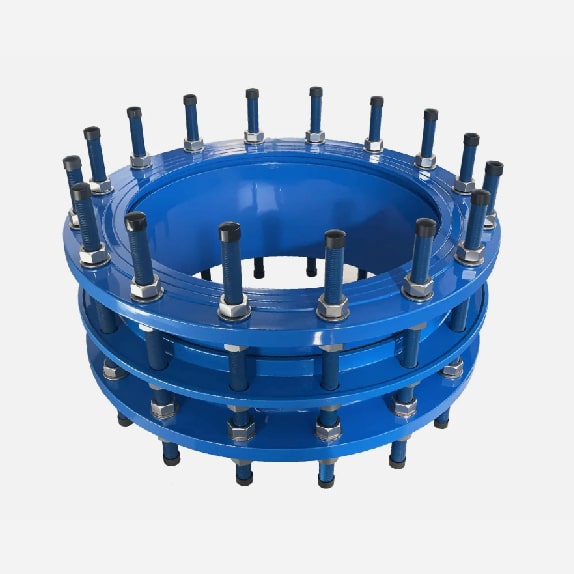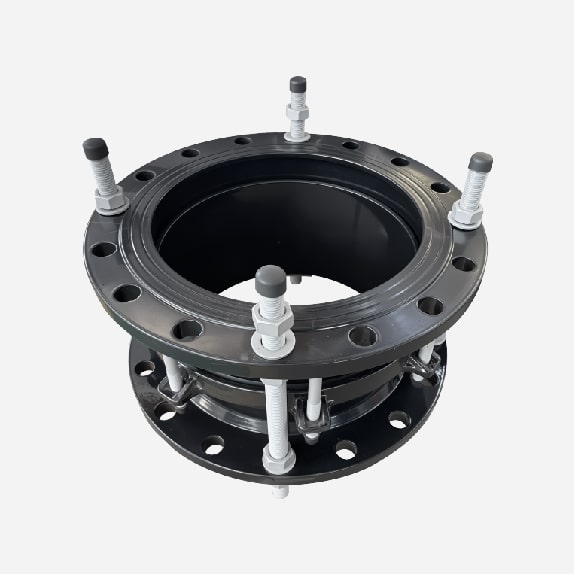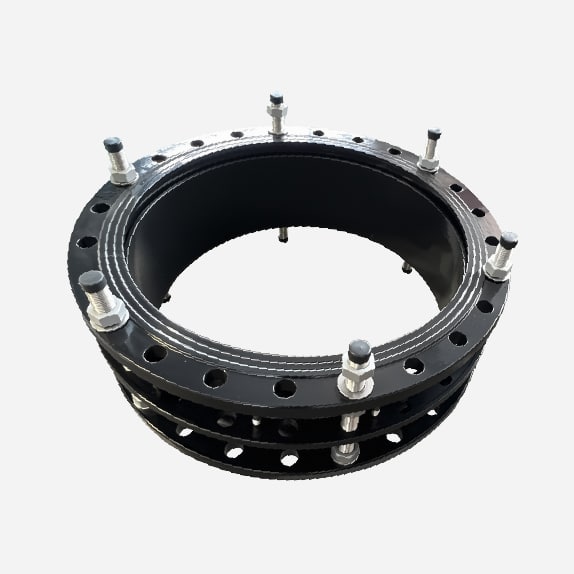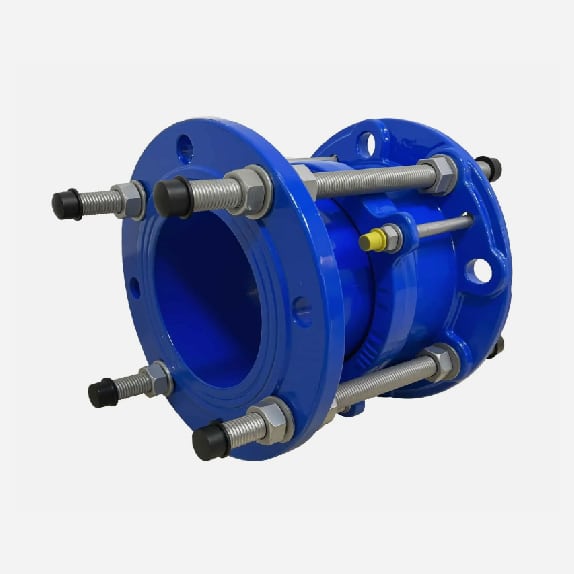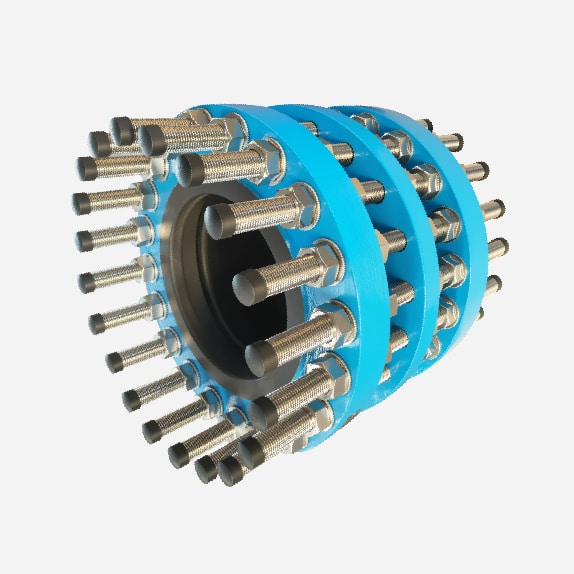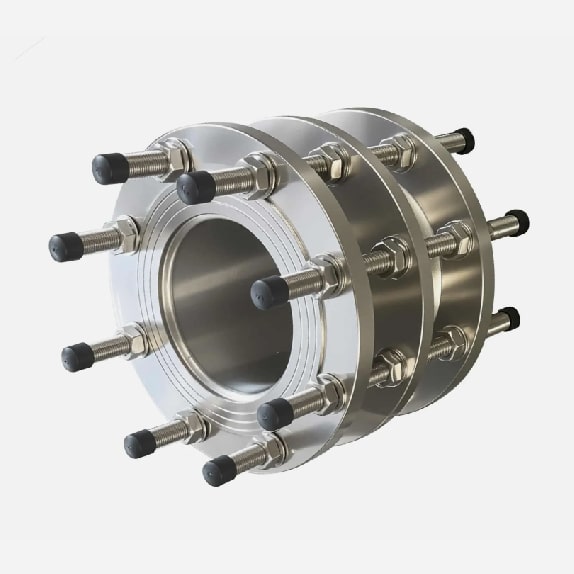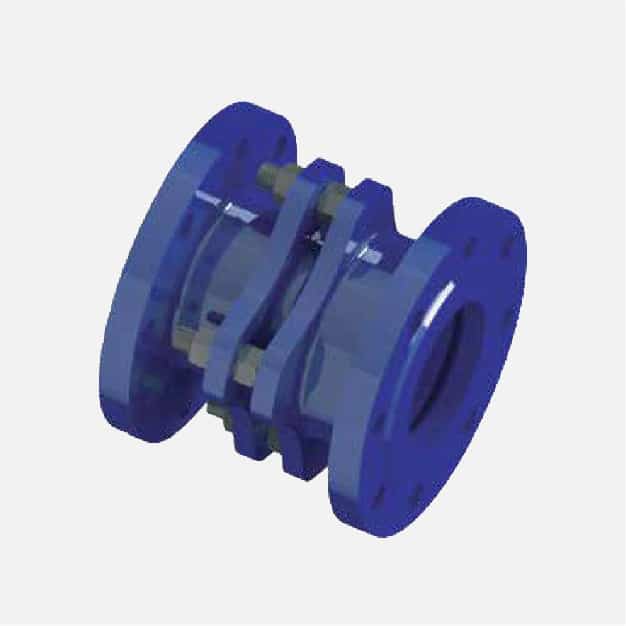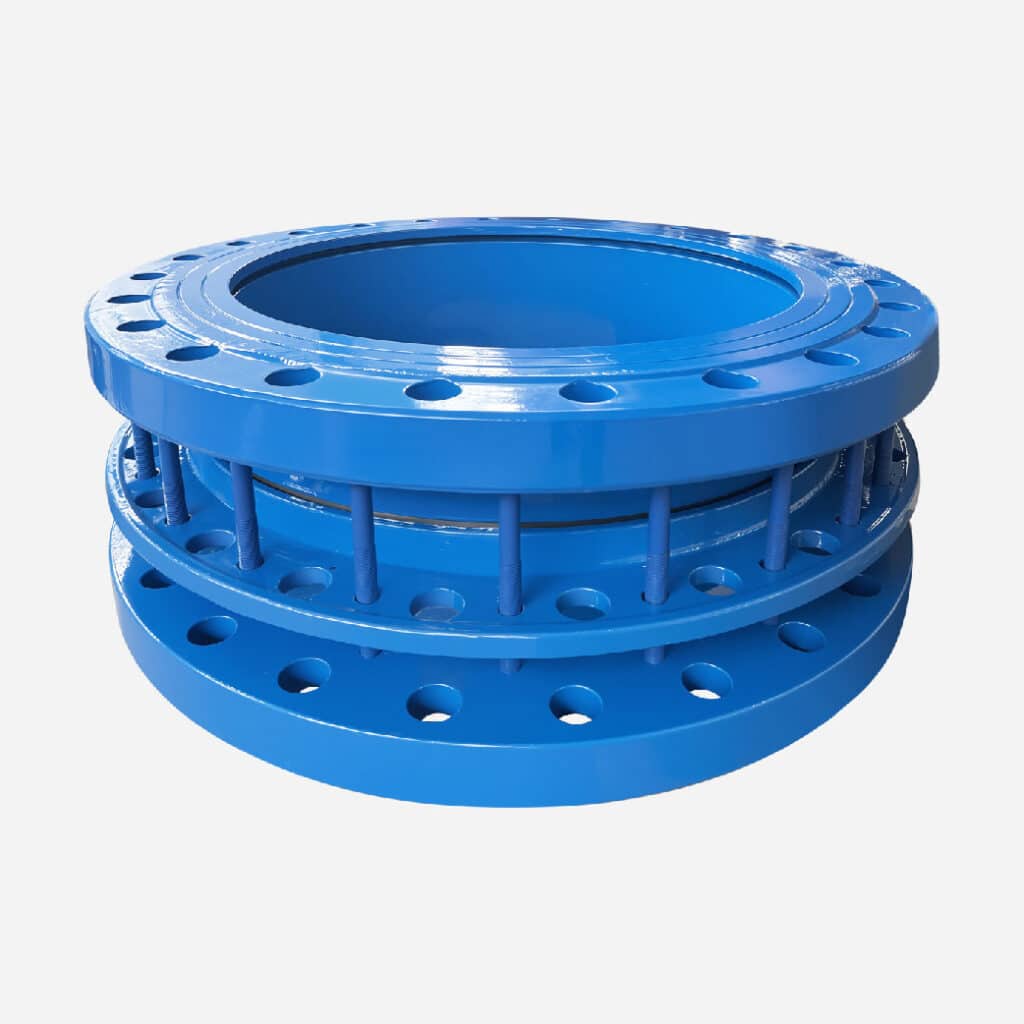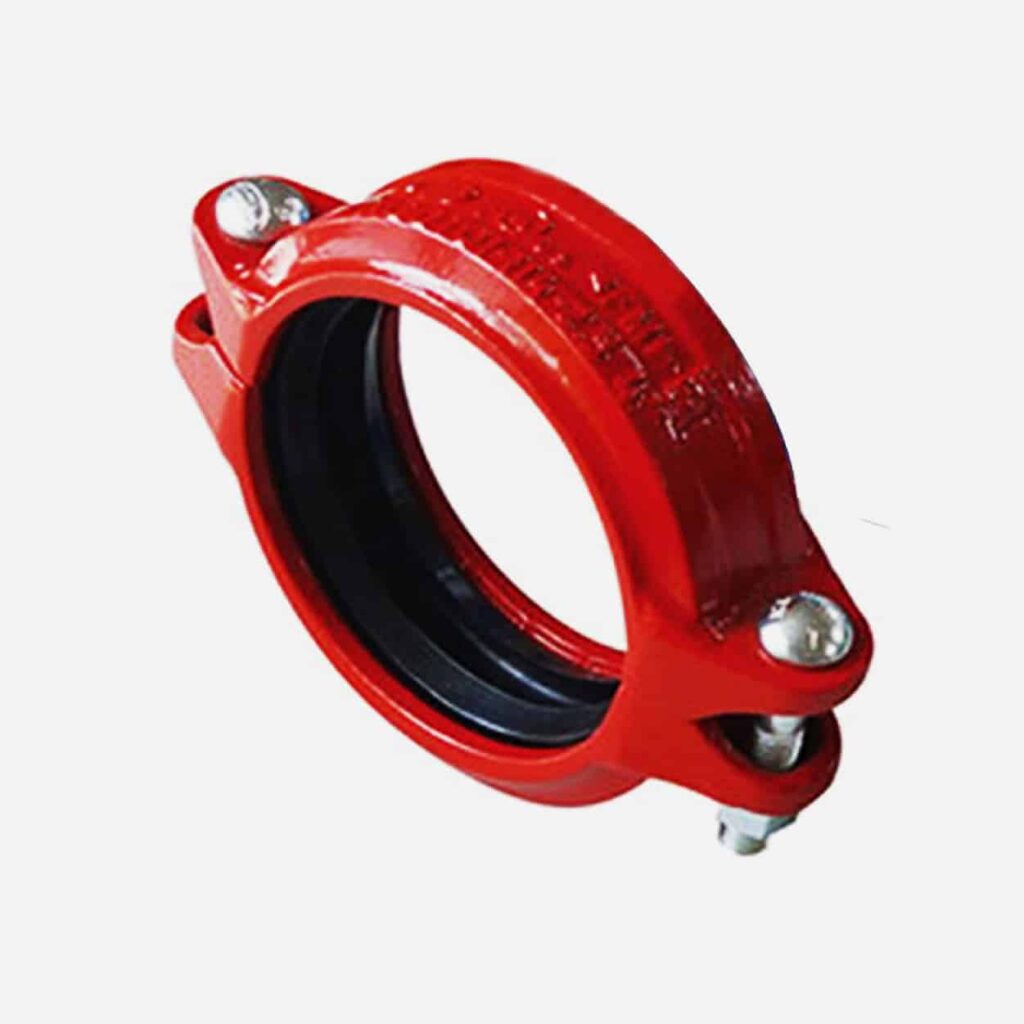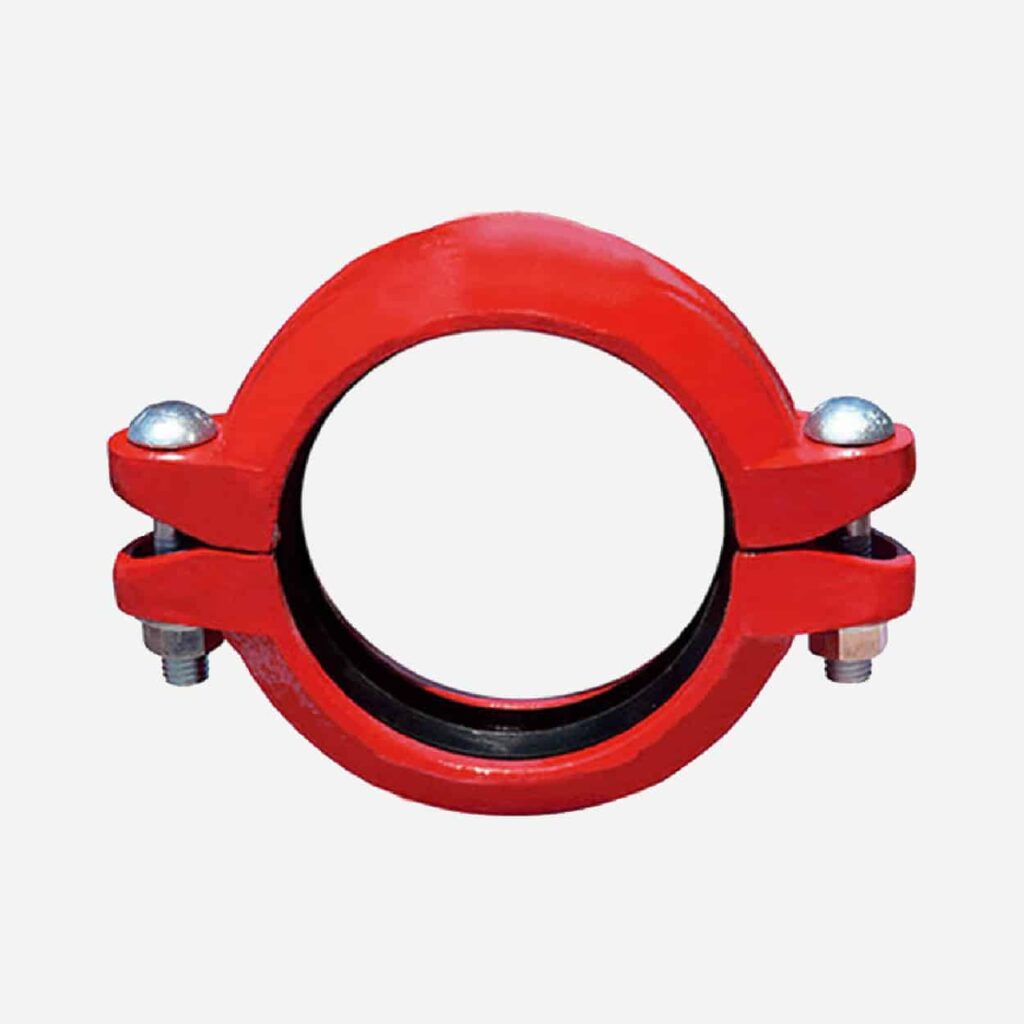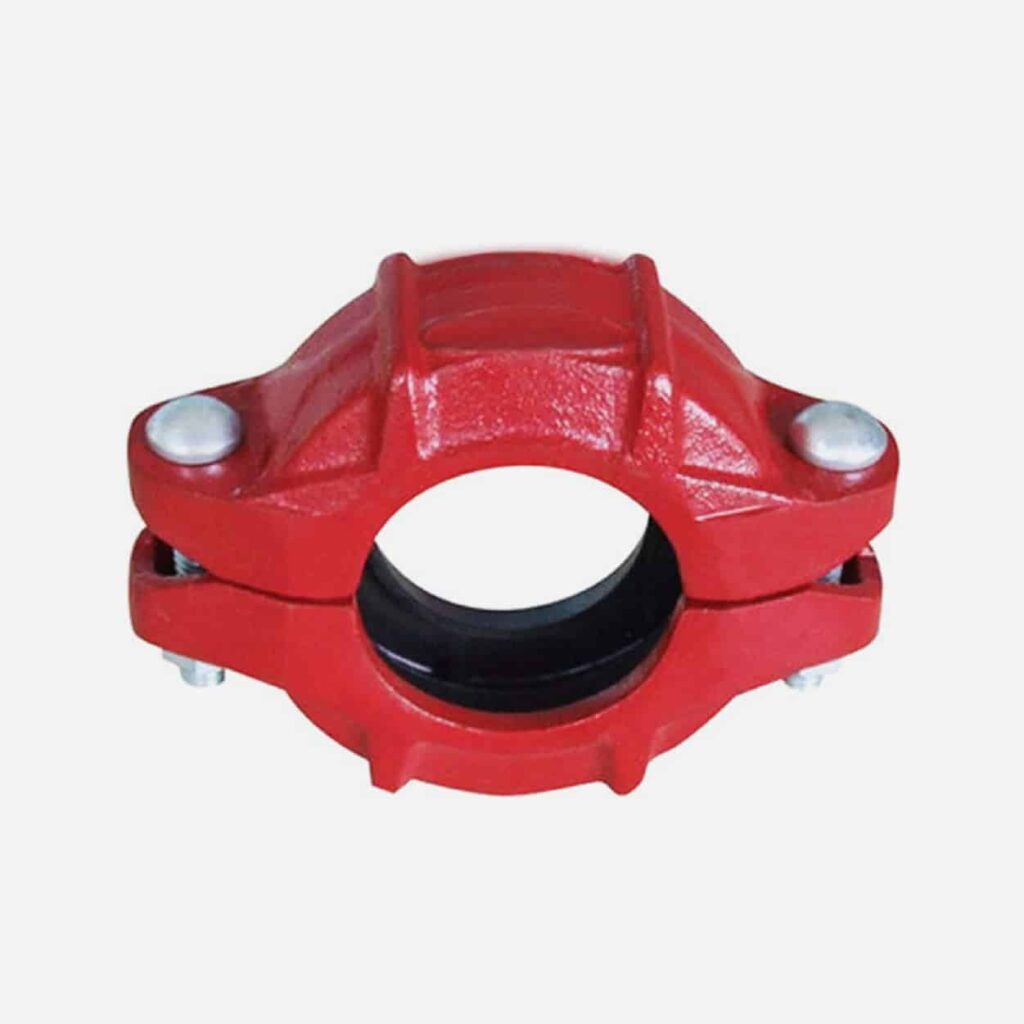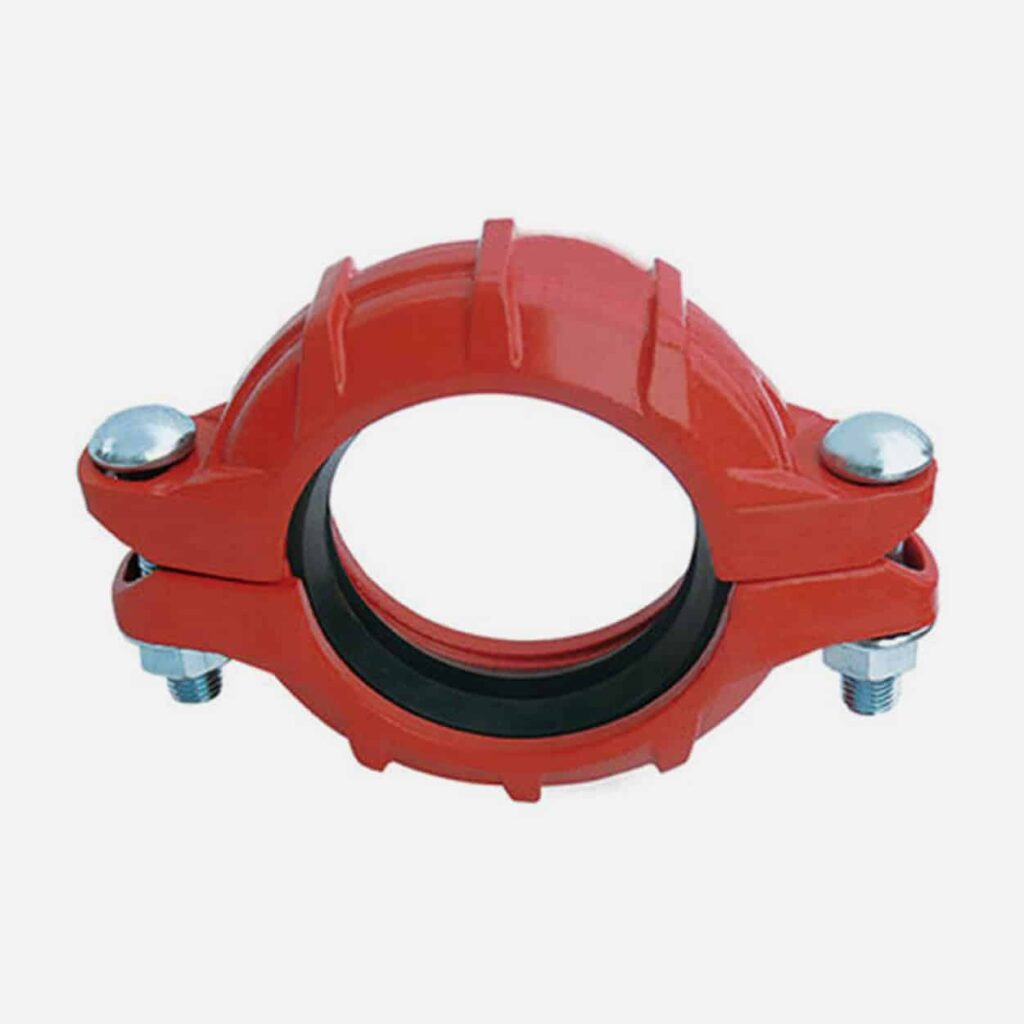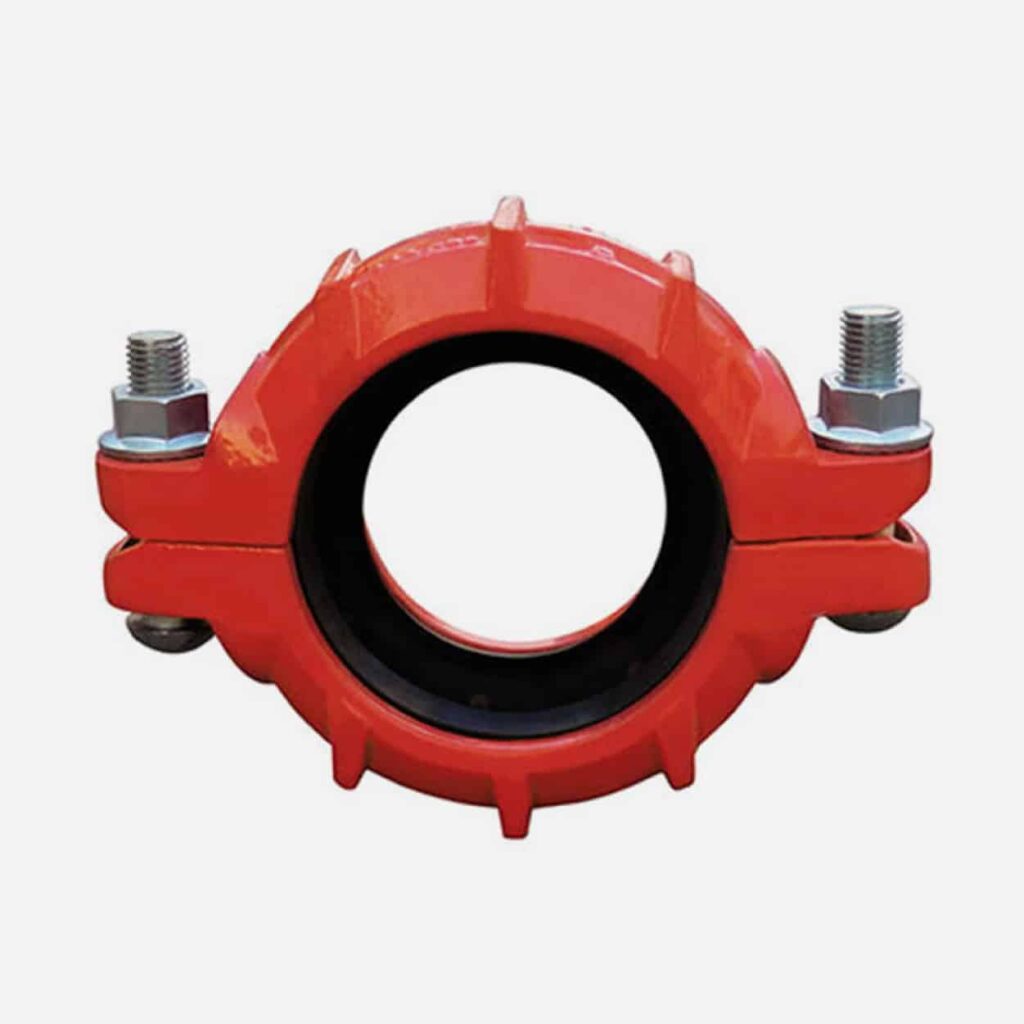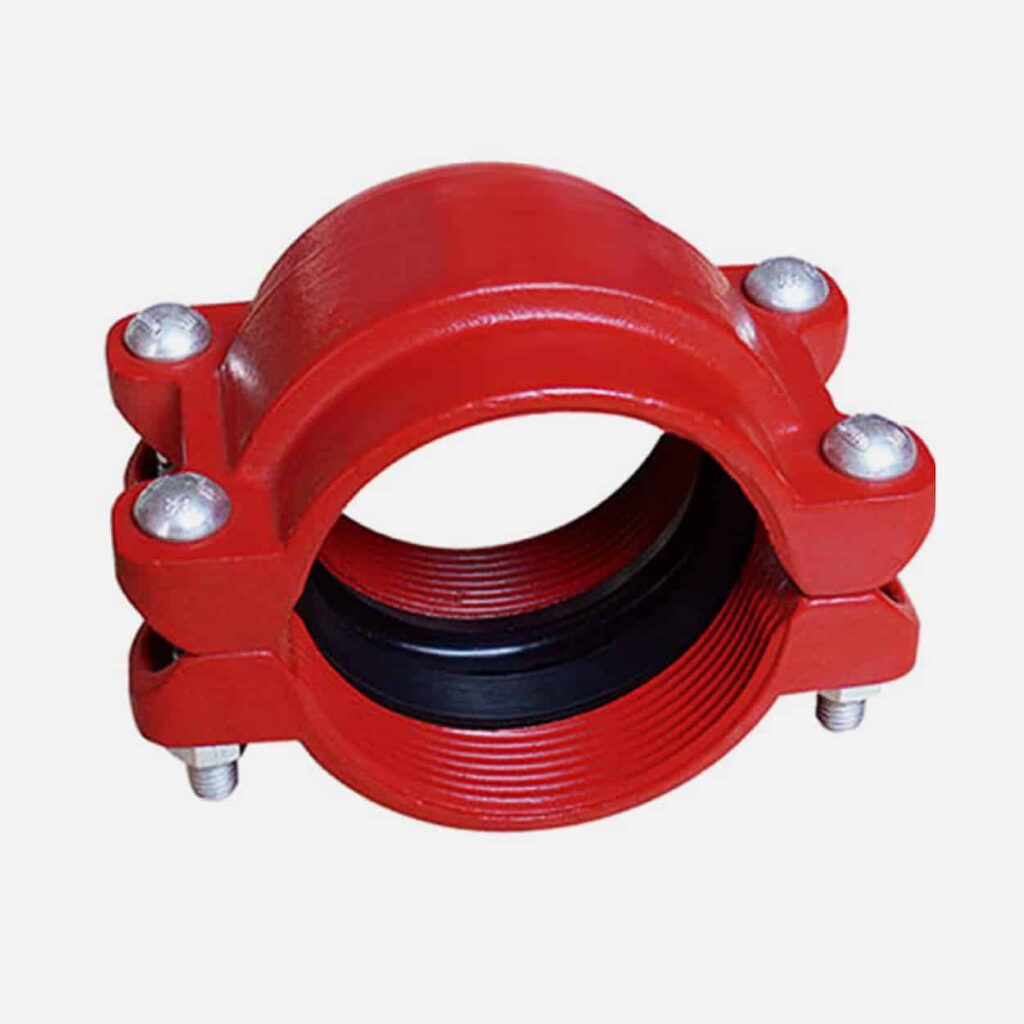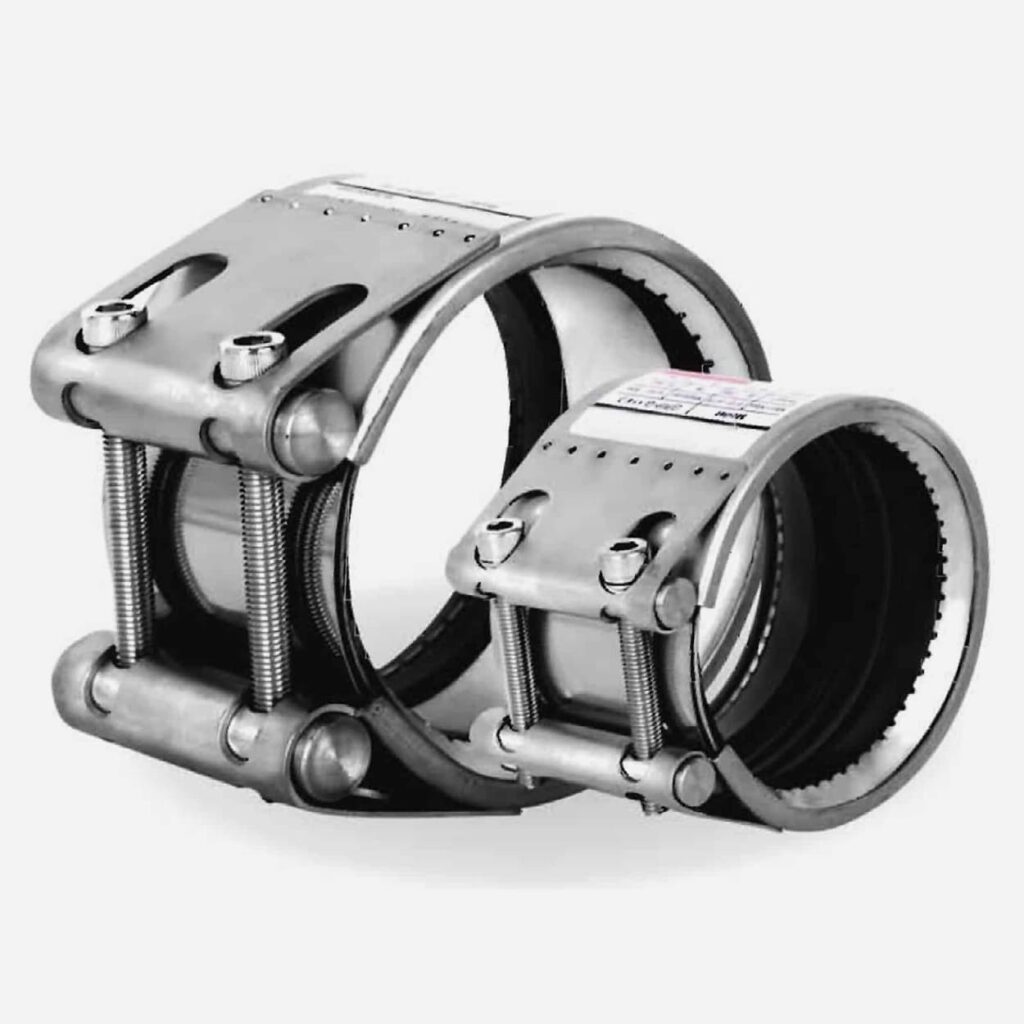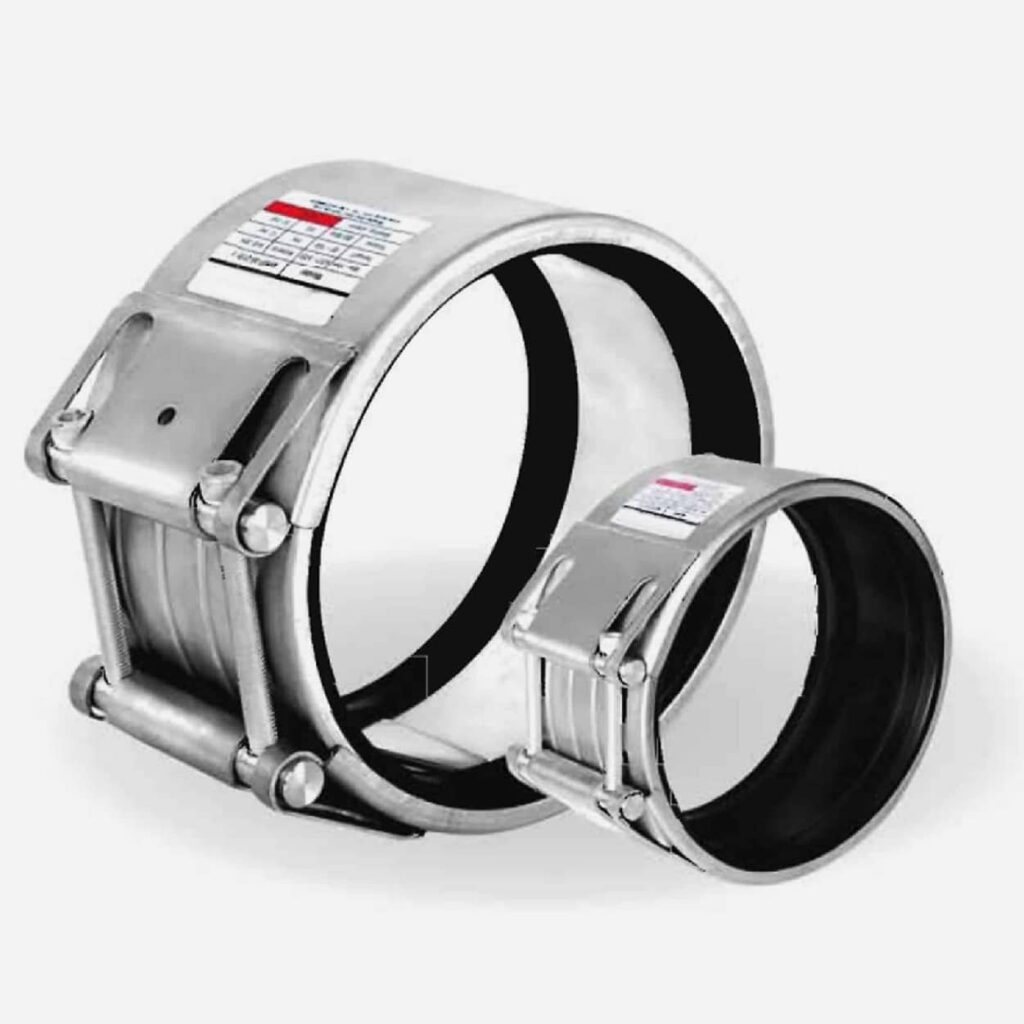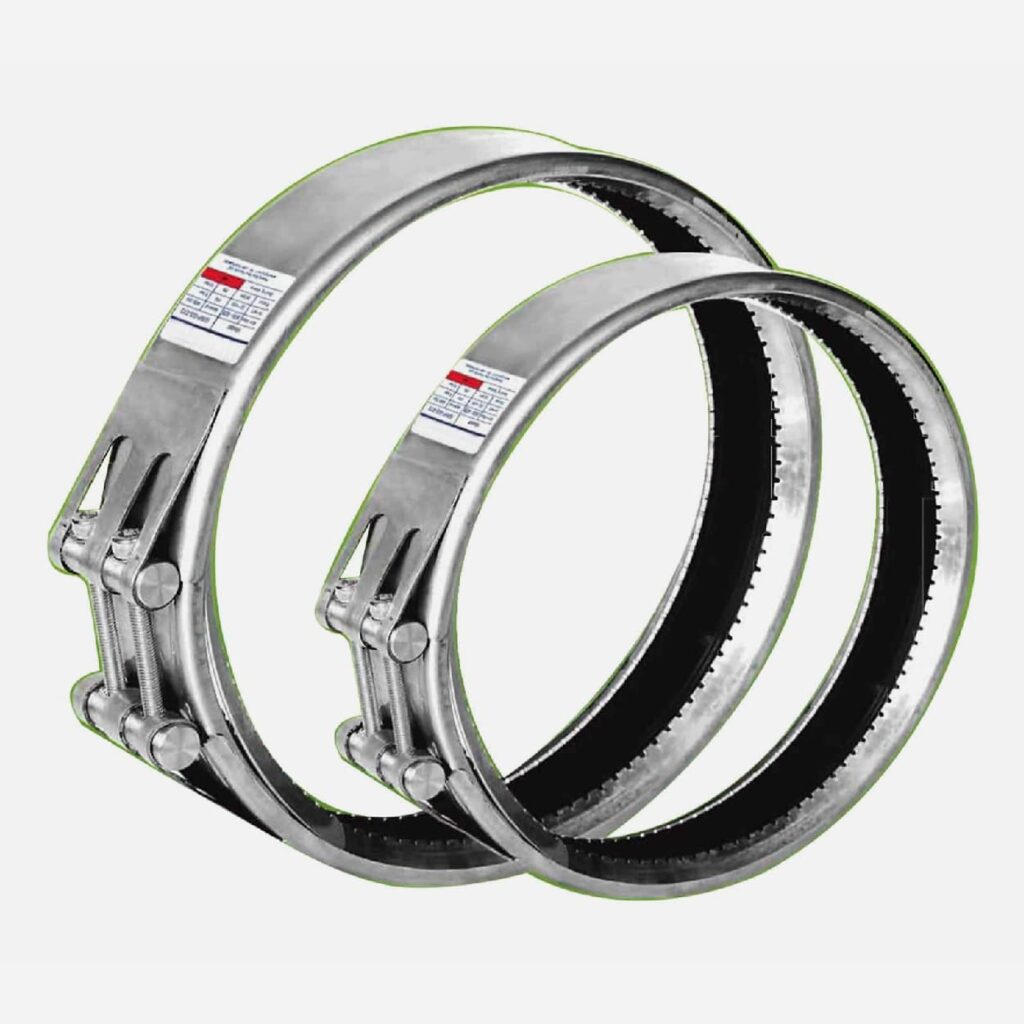Pipe couplings are mainly used to connect two pipes together to make the pipeline continue. It can also be used to repair pipes (repair coupling clamp), change the size or material of the pipe (step coupling), change the direction of the pipe (angle coupling), facilitate the maintenance of the pipeline, use the flexible characteristics of the pipe coupling to absorb the movement or vibration of the pipeline, and coupling allow the pipe to be misaligned, which can be used to align the pipe.
FLEXIBLE PIPE COUPLING
A flexible pipe coupling is a fitting used to connect two sections of pipe that allows for movement and deformation within a certain range.
The gaskets in flexible pipe couplings are made of elastic materials (such as rubber or other synthetic materials) that can absorb and dissipate stress and vibration in a pipe system. They are highly effective in applications where pipes need to accommodate thermal expansion, ground settlement, or minor misalignment.
MULTIGRIP RESTRAINED UNIVERSAL COUPLING
Sr No. 010
● MATERIAL DI
● FUNCTION
It can be used to connect HDPE pipes (with SS304 gripper and POM retractable ring), and it can also be used to connect ductile iron pipes, steel pipes, PVC pipes, etc. (without SS304 gripper, but with POM retractable ring). Since both ends have independent locking mechanisms, it can also be used to connect pipes of different materials or different outer diameters. However, make sure that the outer diameters of the pipes are within our design range.
MECHANICAL COUPLING JOINT WITH HARNESS
Sr No. JC014
● MATERIAL STEEL
● FUNCTION
A harness was added to the standard coupling. The harness is welded onto the pipes to be connected, and tie rods are inserted to prevent pipe movement, thereby avoiding leakage at the joint.
UNIVERSAL COUPLING
Sr No. JC001
● MATERIAL DI & Steel
● FUNCTION
Connect two pipes plain ends (Ductile iron pipe,Cast iron pipe,AC pipe ,PVC pipe ,Steel pipe etc which pipe OD is in our designed range,Don’t suitable for HDPE pipe),Pipes outside diameter should be same for both ends or small gap.
DEDICATED COUPLING
Sr No. JC012
● MATERIAL DI & Steel
● FUNCTION
Connect two pipes plain ends (one coupling suit for only one specific pipe,Don’t suitable for HDPE pipe).
RESTRAINED TRANSITION COUPLING
Sr No. JC013
● MATERIAL DI
● FUNCTION
Connect two pipes with different outside diameter ,with griper to avoid pipe to be pulled out.
PIPE COUPLING CLAMP
Sr No. JC007
● MATERIAL DI
● FUNCTION
Restraint coupling for two spigot ends of PE or PVC pipe, also can transit PE to PVC pipe.
STEP
COUPLING
Sr No. JC004
● MATERIAL DI
● FUNCTION
Transit one material pipe to another material pipe or transit one size pipe to another different size pipe, can’t used to HDPE pipe.
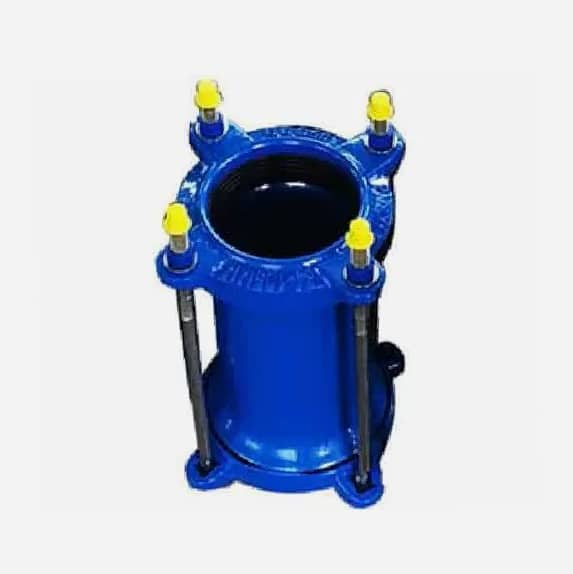
LONG UNIVERSAL COUPLING
Sr No. JC005
● MATERIAL DI
● FUNCTION
Connect two pipes plain ends which are with same outside diameter, not suitable for HDPE pipe
DRESSER
COUPLING
Sr No. JC006
● MATERIAL DI &steel
● FUNCTION
Connect two specific pipes plain ends , can withstand higher pressure up to 330psi
UNIVERSAL COUPLING
Sr No. JC002
● MATERIAL DI
● FUNCTION
Connect two pipes plain ends (Ductile iron pipe,Cast iron pipe,AC pipe ,PVC pipe ,Steel pipe etc which pipe OD is in our designed range,Don’t suitable for HDPE pipe),Pipes outside diameter should be same for both ends or small gap.
COUPLING WITH LOCATING PLUG
Sr No. JC004
● MATERIAL DI
● FUNCTION
Plug prevent the pipe from sliding inside coupling, Suitable for ground vibration, thermal expansion and contraction, etc project situation, for above-ground pipelines.
INSULATING COUPLING
Sr No. JC015
● MATERIAL DI End Ring with Carbon Steel Middle Sleeve
● FUNCTION
Connect stainless steel pipe and carbon steel pipe, preventing electrochemical corrosion problems.
GIBAULT COUPLING
Gibault coupling is a mechanical coupling used for pipe connections, usually used to connect or repair PVC pipes, cast iron pipes, HDPE pipes, and other types of pipeline systems.
Gibault couplings are single-range and are named for their easy and fast installation and efficient sealing performance, most commonly used in low-pressure PVC pipe.
FLANGE COUPLING
Flange coupling is one of pipe couplings.With flange in one end to connect with flanges from neighbour pipeline parts, with socket in another end to connect pipe plain ends.So it is widely used to connect one pipe to valves, water meters, flow meters etc pipeline elements.
AQUAGRIP FLANGE COUPLING
Sr No. FA003
● MATERIAL DI
● FUNCTION
It can be used to connect flange to HDPE pipes (with SS304 gripper and POM retractable ring), and it can also be used to connect flange to ductile iron pipes, steel pipes, PVC pipes, etc. (without SS304 gripper, but with POM retractable ring). However, make sure that the outer diameters of the pipes are within our design range.
WIDE RANGE FLANGE COUPLING FOR HDPE PIPE
Sr No. FA013
● MATERIAL DI
● FUNCTION
Connect flange to HDPE pipes ,ductile iron pipes, steel pipes etc ,please make sure your pipe outside diameter is in our designed range.
DUCTILE IRON RANGER FLANGE COUPLING
Sr No. FA005
● MATERIAL DI
● FUNCTION
Connect flange to pipes(Ductile iron pipe,Cast iron pipe,AC pipe ,PVC pipe ,Steel pipe etc which pipe OD is in our designed range,Don’t suitable for HDPE pipe)
FLANGE COUPLING WITH HARNESS TO AVOID PIPE MOVEMENT
Sr No. FA015
● MATERIAL DI
● FUNCTION
Connect pipe to flange equipment ,with harness to grip pipe to avoid pipe movement
STEEL FLANGE COUPLING
Sr No. FA007
● MATERIAL Steel
● FUNCTION
Connect flange to one specific pipe(Ductile iron pipe or Steel pipe etc ,Don’t suitable for HDPE pipe)
DEDICATED FLANGE COUPLING
Sr No. FA006
● MATERIAL DI
● FUNCTION
Connect flange to one specific pipes(Ductile iron pipe or Steel pipe etc),don’t suitable for HDPE pipe
RESTRAINED FLANGE COUPLING FOR HDPE PIPE
Sr No. FA008
● MATERIAL DI
● FUNCTION
Connect flange to HDPE pipe
UNIVERSAL FLANGE COUPLING
Sr No. FA001
● MATERIAL DI
● FUNCTION
Connect flange to pipes(Ductile iron pipe,Cast iron pipe,AC pipe ,PVC pipe ,Steel pipe etc which pipe OD is in our designed range,Don’t suitable for HDPE pipe)
MECHANICAL JOINT FLANGE COUPLING
Sr No. FA002
● MATERIAL DI
● FUNCTION
Connect flange to pipes(Ductile iron pipe,Cast iron pipe,AC pipe ,PVC pipe ,Steel pipe etc which pipe OD is in our designed range)
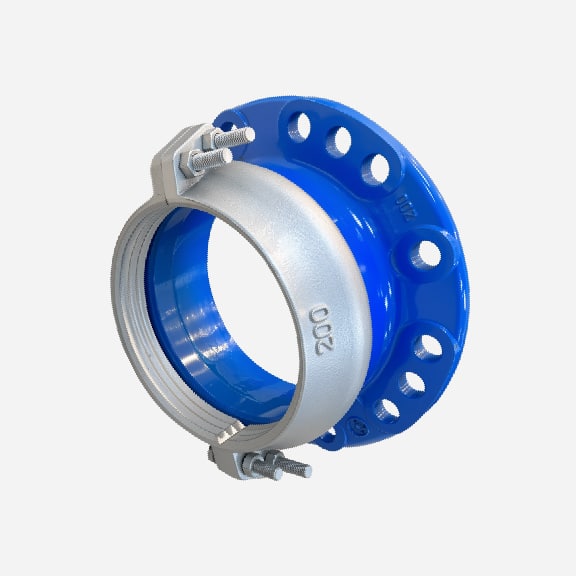
FLANGE ADAPTOR COUPLING
Sr No. FA014
● MATERIAL DI
● FUNCTION
Connect flange to HDPE pipes , with grip ring to grip HDPE pipe to avoid it is pulled out.
QUICK FLANGE COUPLING FOR HDPE PIPE
Sr No. FA011
● MATERIAL DI
● FUNCTION
Connect flange to HDPE pipe

STEP FLANGE COUPLING FOR LARGER PIPE
Sr No. FA010
● MATERIAL DI
● FUNCTION
Connect flange to larger pipe than flange nominal diameter
DISMANTLING COUPLING
A dismantling coupling is a type of pipe fitting used to connect and dismantle components in a pipeline system, such as valves, pumps, and other equipment.
It allows these items to be easily installed and removed without having to significantly move the pipes, simplifying maintenance and repair processes. Dismantling couplings are typically used in pipeline systems that require frequent maintenance.
HEAVY DUTY DISMANTLING JOINT
Sr No. DJ001
● MATERIAL DI
● FUNCTION
Provides space for neighbouring parts disassembling by changing its own length
HEAVY DUTY DISMANTLING JOINT
Sr No. DJ002
● MATERIAL DI
● FUNCTION
Provides space for neighbouring parts disassembling by changing its own length
HEAVY DUTY DISMANTLING JOINT
Sr No. DJ003
● MATERIAL DI
● FUNCTION
Provides space for neighbouring parts disassembling by changing its own length
HEAVY DUTY DISMANTLING JOINT
Sr No. DJ004
● MATERIAL DI
● FUNCTION
Provides space for neighbouring parts disassembling by changing its own length
LIGHT DUTY DISMANTLING JOINT
Sr No. DJ005
● MATERIAL DI
● FUNCTION
Provides space for neighbouring parts disassembling by changing its own length
Light Duty Dismantling Joint
Sr No. DJ006
● MATERIAL DI
● FUNCTION
Provides space for neighbouring parts disassembling by changing its own length
Light Duty Dismantling Joint
Sr No. DJ007
● MATERIAL DI
● FUNCTION
Provides space for neighbouring parts disassembling by changing its own length
LIGHT DUTY DISMANTLING JOINT
Sr No. DJ008
● MATERIAL DI
● FUNCTION
Provides space for neighbouring parts disassembling by changing its own length
HEAVY DUTY DISMANTLING JOINT
Sr No. DJ009
● MATERIAL DI
● FUNCTION
Provides space for neighbouring parts disassembling by changing its own length
HEAVY DUTY DISMANTLING JOINT
Sr No. DJ010
● MATERIAL STEEL
● FUNCTION
Provides space for neighbouring parts disassembling by changing its own length
HEAVY DUTY DISMANTLING JOINT
Sr No. DJ011
● MATERIAL STAINLESS STEEL
● FUNCTION
Provides space for neighbouring parts disassembling by changing its own length.
LIGHT DUTY DISMANTLING JOINT
Sr No. DJ012
● MATERIAL CARBON STEEL
● Feature Sealing is achieved by compressing the gasket with a centrally positioned, independent gland and very short bolts, making installation extremely quick and easy.
Sr No. DJ013
● MATERIAL DUCTILE IRON
● Feature
Allows the installation length to be adjusted by tightening bolts and nuts, which moves the long body within the short body.
Sr No. DJ014
● MATERIAL DUCTILE IRON
● Feature
Allows the installation length to be adjusted by tightening bolts and nuts, which moves the long body within the short body.
Sr No. DJ015
● MATERIAL DUCTILE IRON
● Feature
Allows the installation length to be adjusted by tightening bolts and nuts, which moves the long body within the short body.
Sr No. DJ016
● MATERIAL DUCTILE IRON
● Feature
This dismantling joint is designed with four flanges. The flange without the bolts can be connected to the adjacent pipeline component with its own separate bolts. When you adjust the length of the dismantling joint, you don’t have to worry about the bolts hitting any expensive pipeline components.
GROOVE COUPLINGS
Grooved coupling is a pipe fitting used to connect grooved-end pipes. It consists of a metal housing, a rubber gasket, and bolts & nuts. During installation, the gasket is placed over the pipe ends, the housing is fitted around it, and the bolts are tightened. This locks the coupling into the grooves on the pipes, creating a secure and leak-proof connection.
Judberd is a Chinese manufacturer of many different types of grooved couplings, including flexible couplings that allow for movement due to thermal expansion, seismic activity, or vibration, rigid couplings that provide a firm, immovable connection similar to welding or flanges, and transition couplings that can connect steel pipe to HDPE pipe, etc. Please check them out below.
DUCTILE IRON GROOVE COUPLING
Rigid Coupling
Sr No. RGC001
● MATERIAL Ductile Iron
● FUNCTION
This coupling is designed to securely connect grooved-end steel pipes, ensuring a stable and immovable joint. It provides a strong and stable connection for high-pressure and fixed pipe systems. It is a high-strength fixed joint.
Flexible Coupling
(Working Pressure 5 Mpa
for small size, 3 Mpa for big size)
Sr No. FGC001
● MATERIAL Ductile Iron
● FUNCTION
It is used to connect grooved-end pipes while allowing a certain degree of flexibility in the system. It absorbs pipe movement, allows for axial displacement, angular deflection, and even vibration absorption. It reduces stress on piping systems – Helps accommodate thermal expansion, contraction, and seismic movement.
Middle pressure flexible coupling
(Working Pressure 7 Mpa for small size, 5 Mpa for big size)
Sr No. FGC002
● MATERIAL Ductile Iron
● FUNCTION
It is used to connect grooved-end pipes while allowing a certain degree of flexibility in the system. It absorbs pipe movement, allows for axial displacement, angular deflection, and even vibration absorption. It reduces stress on piping systems – Helps accommodate thermal expansion, contraction, and seismic movement.
High Pressure Flexible Coupling
(Working Pressure 10 Mpa for small size, 8 Mpa for big size)
Sr No. FGC001
● MATERIAL Stainless Steel
● FUNCTION
It is used to connect grooved-end pipes while allowing a certain degree of flexibility in the system. It absorbs pipe movement, allows for axial displacement, angular deflection, and even vibration absorption. It reduces stress on piping systems – Helps accommodate thermal expansion, contraction, and seismic movement.
Super high pressure flexible coupling
(Working Pressure 15 Mpa for small size, 10.5 Mpa for big size)
Sr No. FGC001
● MATERIAL Ductile Iron
● FUNCTION
This coupling is designed to securely connect grooved-end steel pipes, ensuring a stable and immovable joint. It provides a strong and stable connection for high-pressure and fixed pipe systems. It is a high-strength fixed joint.
Reducing Coupling
Sr No. RGC001
● MATERIAL Ductile Iron
● FUNCTION
Reducing groove coupling is a mechanical pipe coupling used to connect two steel pipes of different diameters.
Shoulder Coupling which connects by relying on the raised shoulder at the end of the pipe
Sr No. SGC001
● MATERIAL Ductile Iron
● FUNCTION
Shouldered groove coupling is a connection method you use when you can’t roll groove or machine thin-wall pipe or large diameter pipe. In that case, you weld rings to the ends of the pipe, and then you install the coupling the same way you would a standard grooved pipe fitting.It has a little bit of flex to it, so it can handle thermal expansion, contraction, or movement in the pipeline.
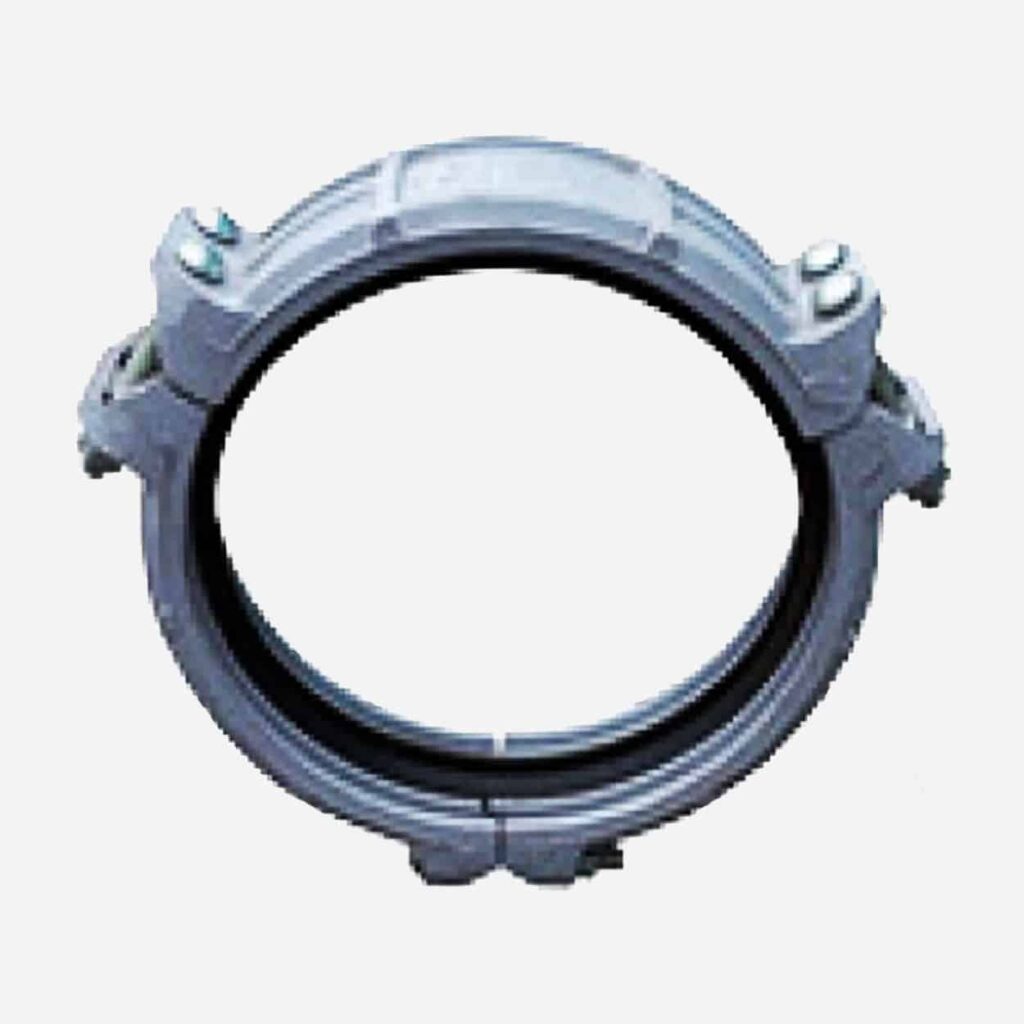
Ring Joint Coupling
Sr No. RJGC001
● MATERIAL Ductile Iron
● FUNCTION
Ring joint coupling is where you weld a ring onto the steel pipe, and then you lock the ring into the groove of the ring joint coupling to make a rigid connection. Once you connect it, the two pipe sections are locked together — they can’t turn or move — which makes it good for systems that have high structural strength requirements.
Coupling for HDPE Pipe
Sr No. GCFPE001
● MATERIAL Ductile Iron
● FUNCTION
The groove coupling for HDPE pipe gets its strength by having sharp teeth that bite into the HDPE pipe, which keeps the pipe from pulling out because HDPE has a tendency to deform.
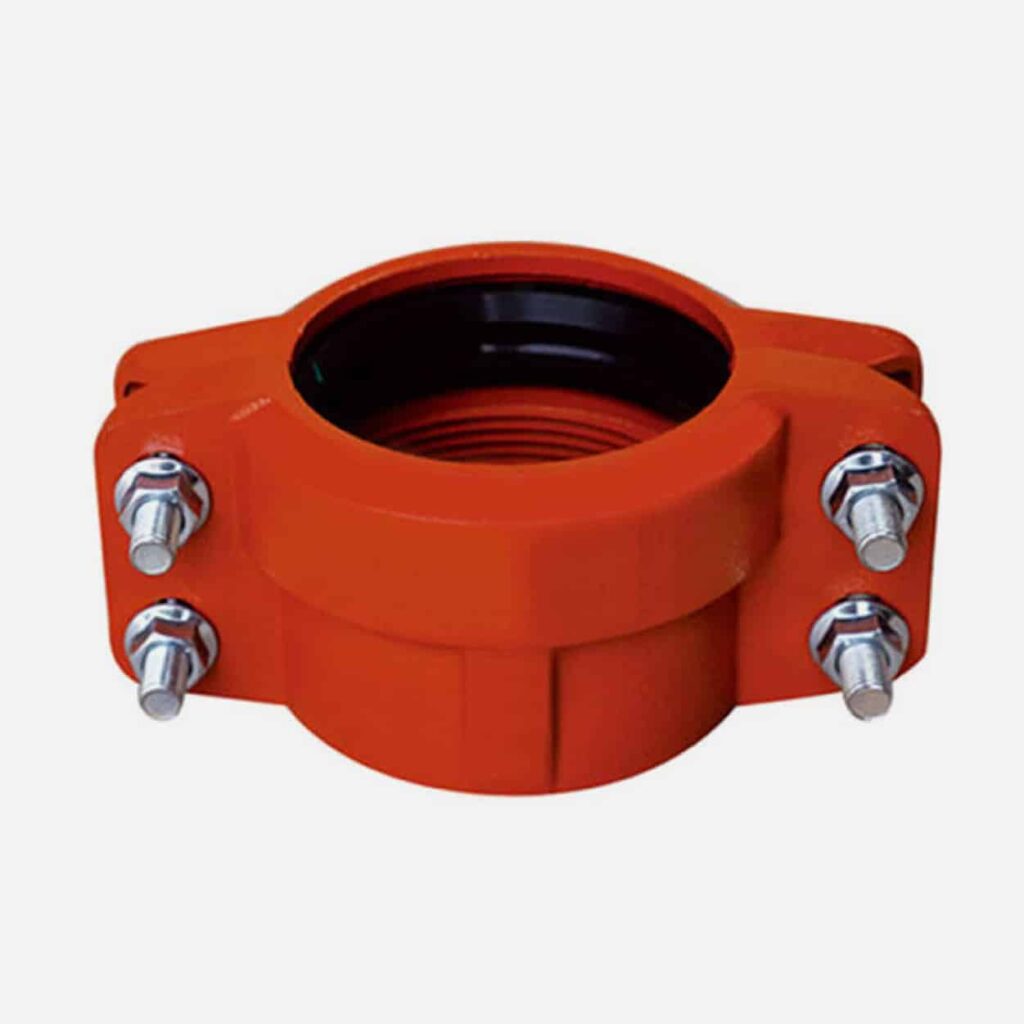
Transition coupling for HDPE pipe to Steel pipe
Sr No. TCPE-Steel001
● MATERIAL Ductile Iron
● FUNCTION
It’s used to connect HDPE pipe to steel pipe, solving the problem of joining two different materials.
The grooved design allows you to install it quickly without welding to connect steel pipe, and the threaded design allows you to install it quickly and easily without heat fusion to connect HDPE pipe.
STAINLESS STEEL PIPE COUPLING
The stainless steel pipe coupling can be used for pipeline connections, and some designs combine the functions of a pipe coupling and a repair clamp.
The stainless steel pipe coupling allows for a certain degree of axial movement and angular deflection of the pipe.
It features a self-sealing structure, where the sealing performance improves as the pressure increases.
Stainless steel pipe coupling with anchor rings to avoid pipes to be pulled out, axially restrained
Sr No. SSPC001
● MATERIAL Stainless Steel
● FUNCTION
Connect pipes, this pipe coupling have two grip rings on both ends to grip pipes, can replace flange ,welding, groove and thread etc connection, quick and easy
stainless steel pipe coupling for pipe connection which allow for pipe expansion and contraction
Sr No. SSPC002
● MATERIAL Stainless Steel
● FUNCTION
Connect pipes, This pipe coupling is designed with thick sealing lips on both ends. When the pipeline expands or contracts due to temperature changes or external forces, the thick sealing lips effectively provide a tight seal to prevent leakage.
Stainless steel pipe coupling with anchor rings to avoid pipes to be pulled out, axially restrained, narrow type for limited space
Sr No. SSPC003
● MATERIAL Stainless Steel
● FUNCTION
Connect pipes, this pipe coupling have two grip rings on both ends to grip pipes, can replace flange ,welding, groove and thread etc connection, quick and easy, narrow type for limited space
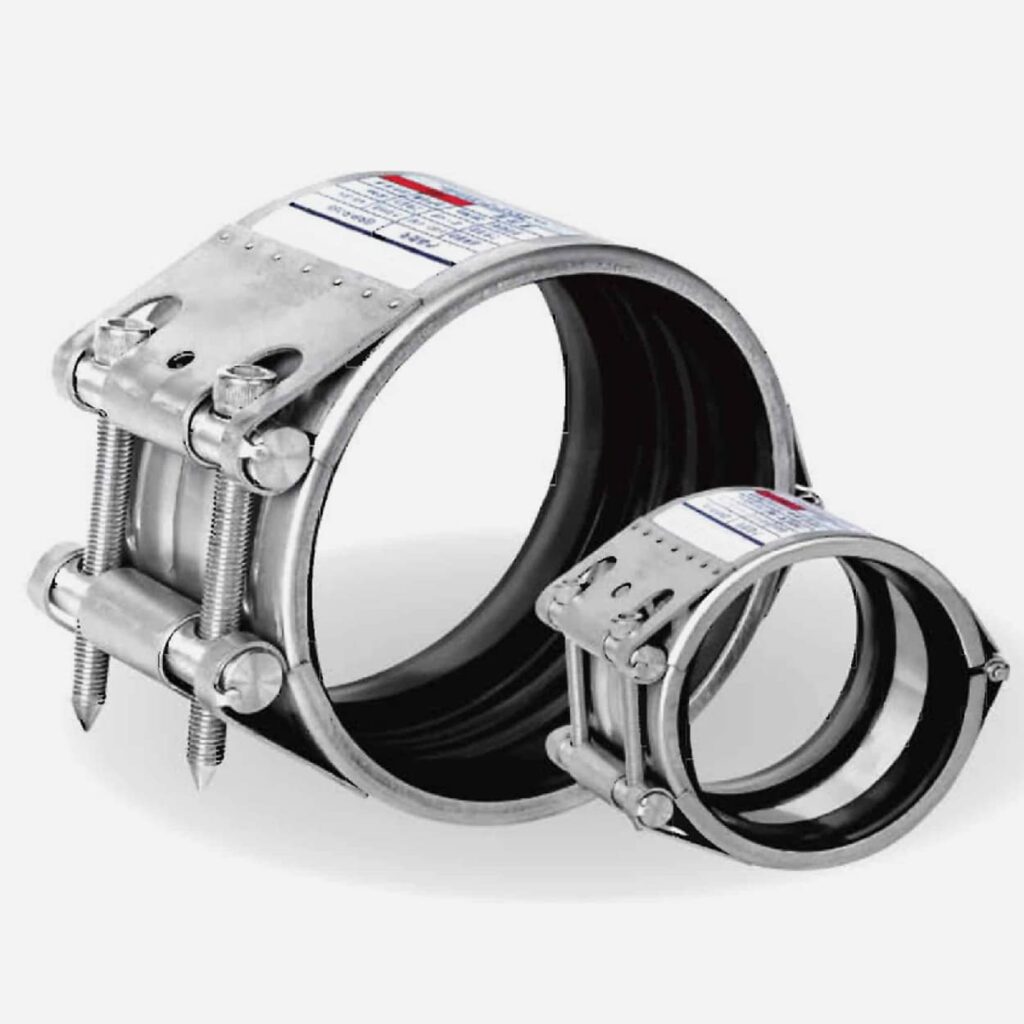
Single band stainless steel pipe repair coupling for permanent repair with pressure in pipeline
Sr No. SSPC004
● MATERIAL Stainless Steel
● FUNCTION
Open the repair coupling, wrap it around the pipe and fasten the tie rods, then you can repair the pipe with pressure inside the pipeline
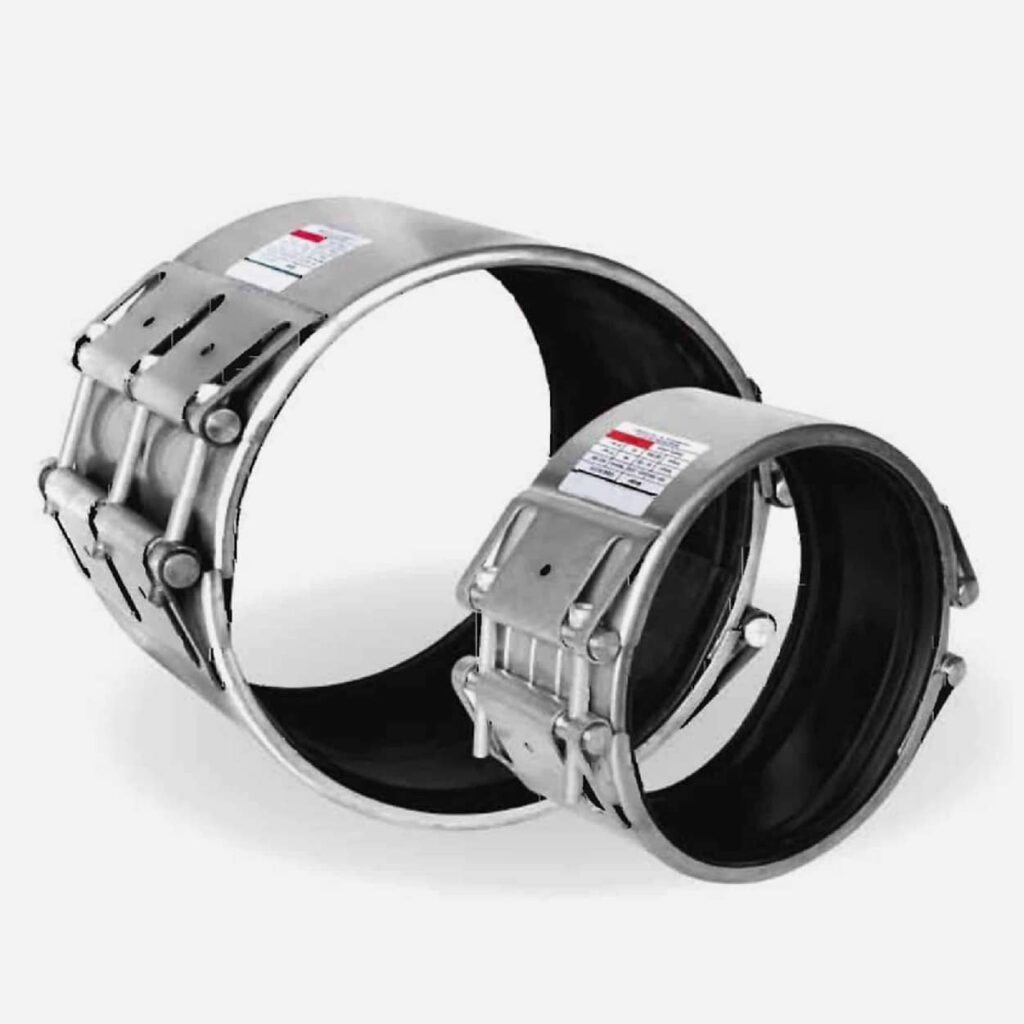
Double bands stainless steel pipe repair coupling for permanent repair with pressure in pipeline
Sr No. SSPC005
● MATERIAL Stainless Steel
● FUNCTION
Open the repair coupling, wrap it around the pipe and fasten the tie rods, then you can repair the pipe with pressure inside the pipeline
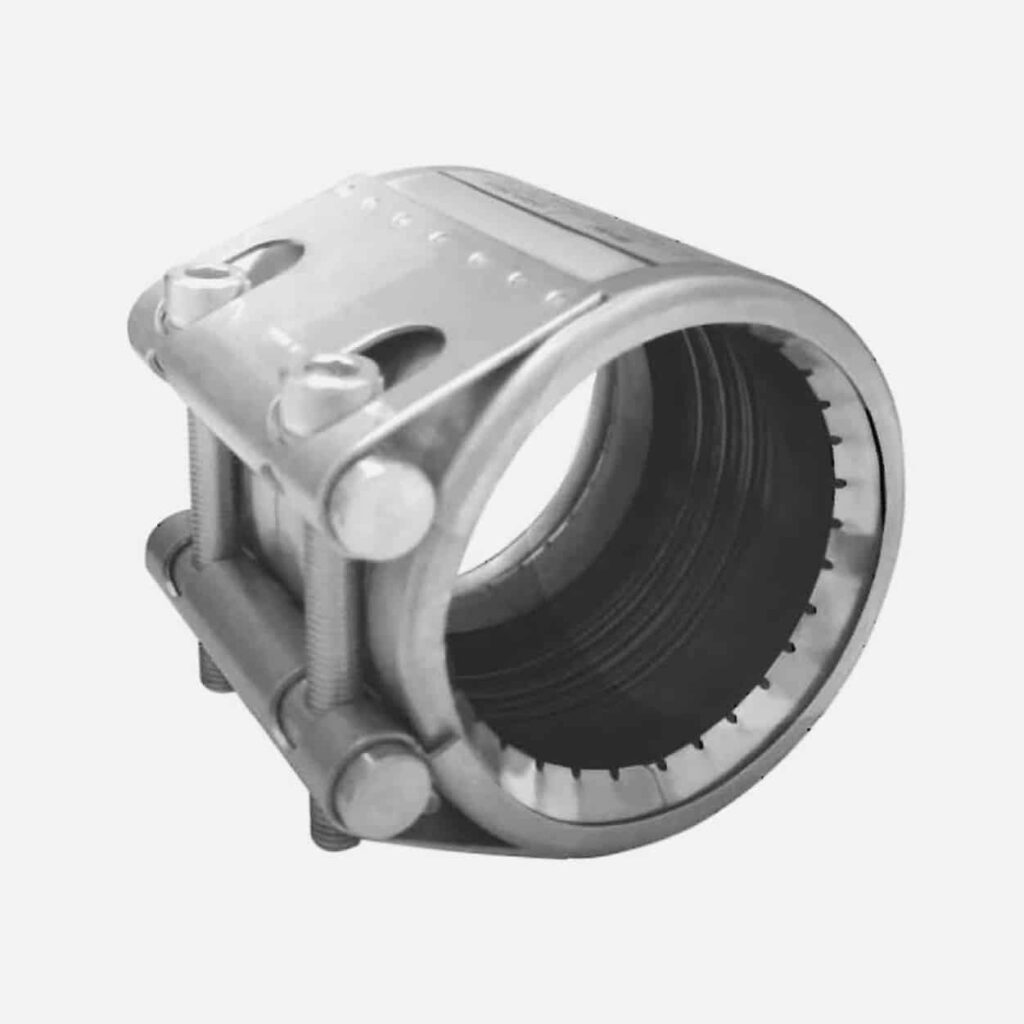
Heavy duty stainless steel pipe coupling for more impact resistance and axial pull-out resistance
Sr No. SSPC006
● MATERIAL Stainless Steel
● FUNCTION
The enhanced pipe coupling, compared to the standard pipe coupling, offers superior impact resistance and a reliable axial pull-out resistance function. The maximum pressure can reach 70 bar (7 MPa).
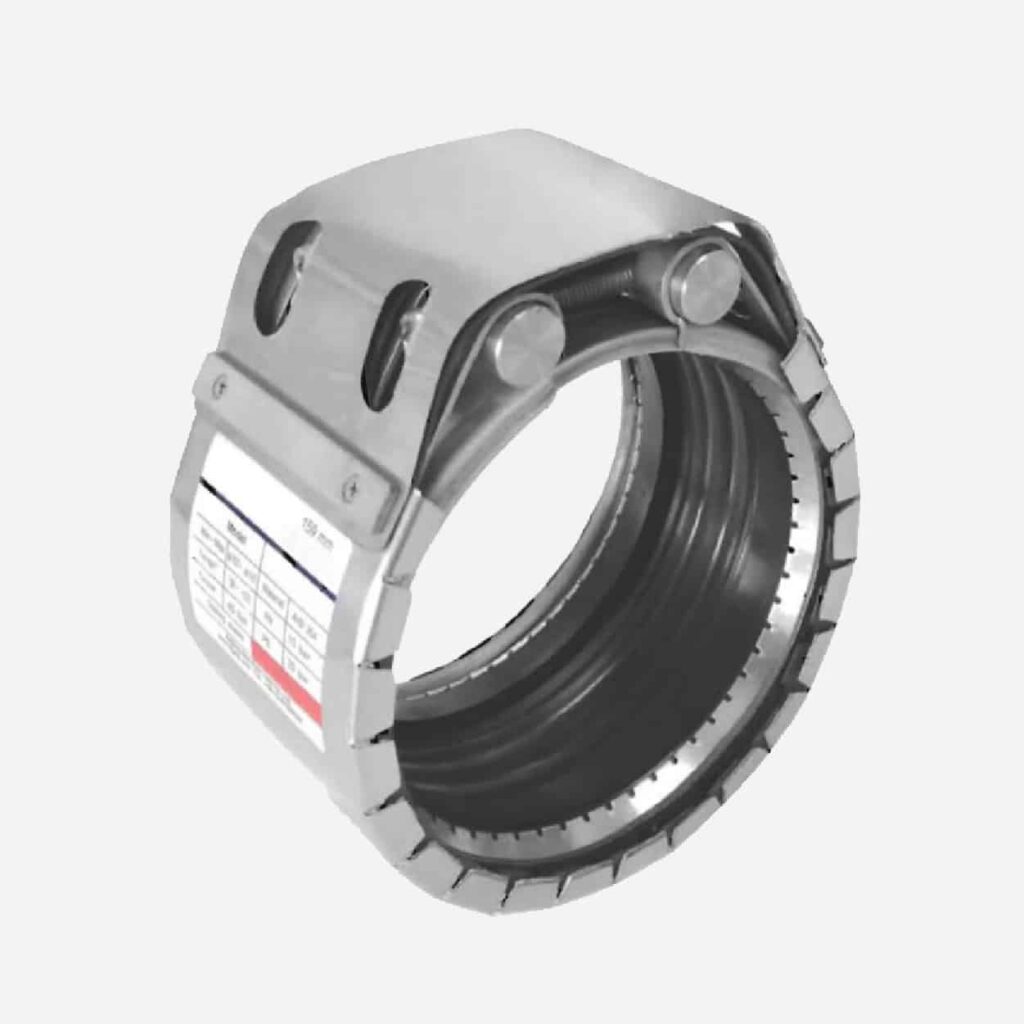
Stainless steel Fire-resistant pipe coupling
Sr No. SSPC007
● MATERIAL Stainless Steel
● FUNCTION
Fire-resistant pipe coupling, suitable for connecting metal pipes of all wall thicknesses, with axial pull-out resistance. It is a high-security fire-protected mechanical pipe coupling. Under high temperatures of +800°C (±50°C), it can provide fire resistance for up to 90 minutes.
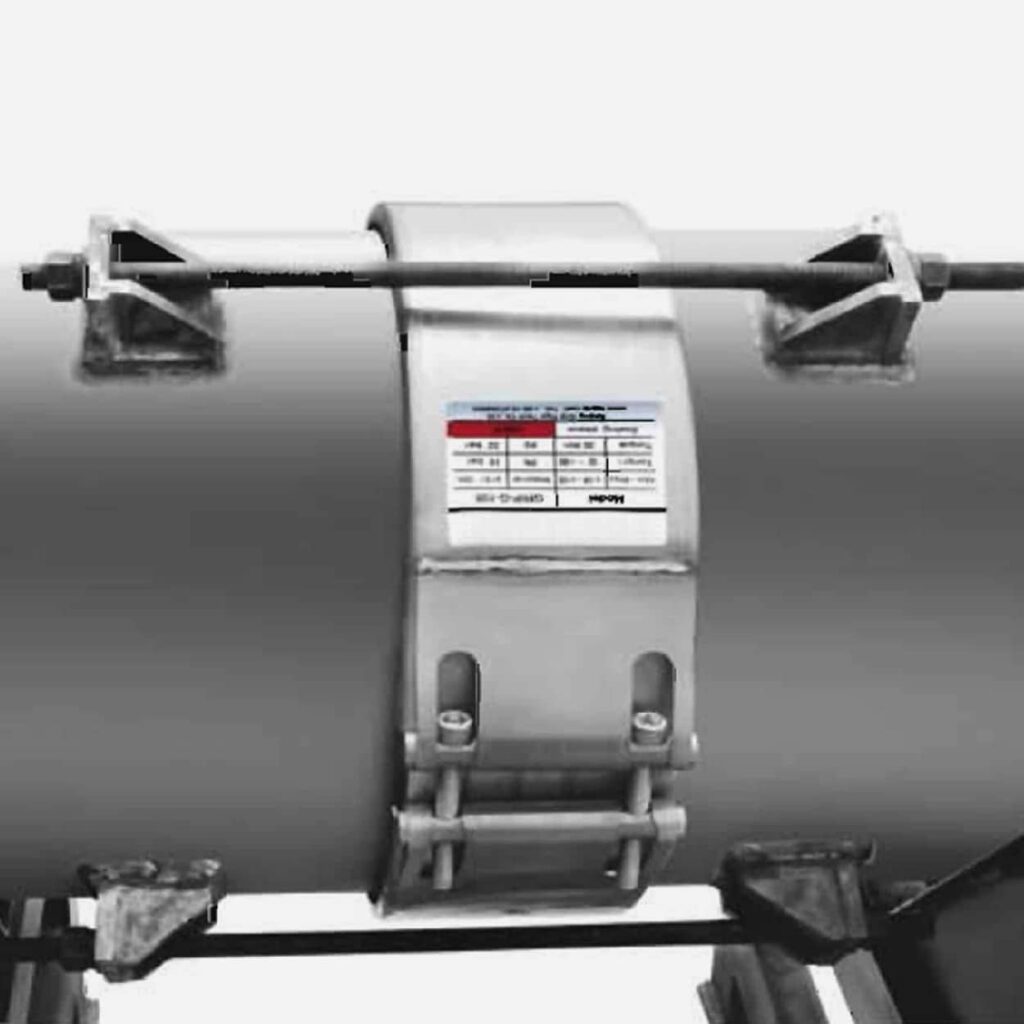
Single band stainless steel pipe repair coupling for permanent repair with pressure in pipeline
Sr No. SSPC008
● MATERIAL Stainless Steel
● FUNCTION
Pipe coupling with tie rods, suitable for pipes made of any material, featuring axial limiting and compensation functions. The combination of limiting tie rods and the pipe coupling allows it to not only serve as a pipe coupling for connection but also provide vibration damping and noise reduction functions similar to those of an expansion joint.
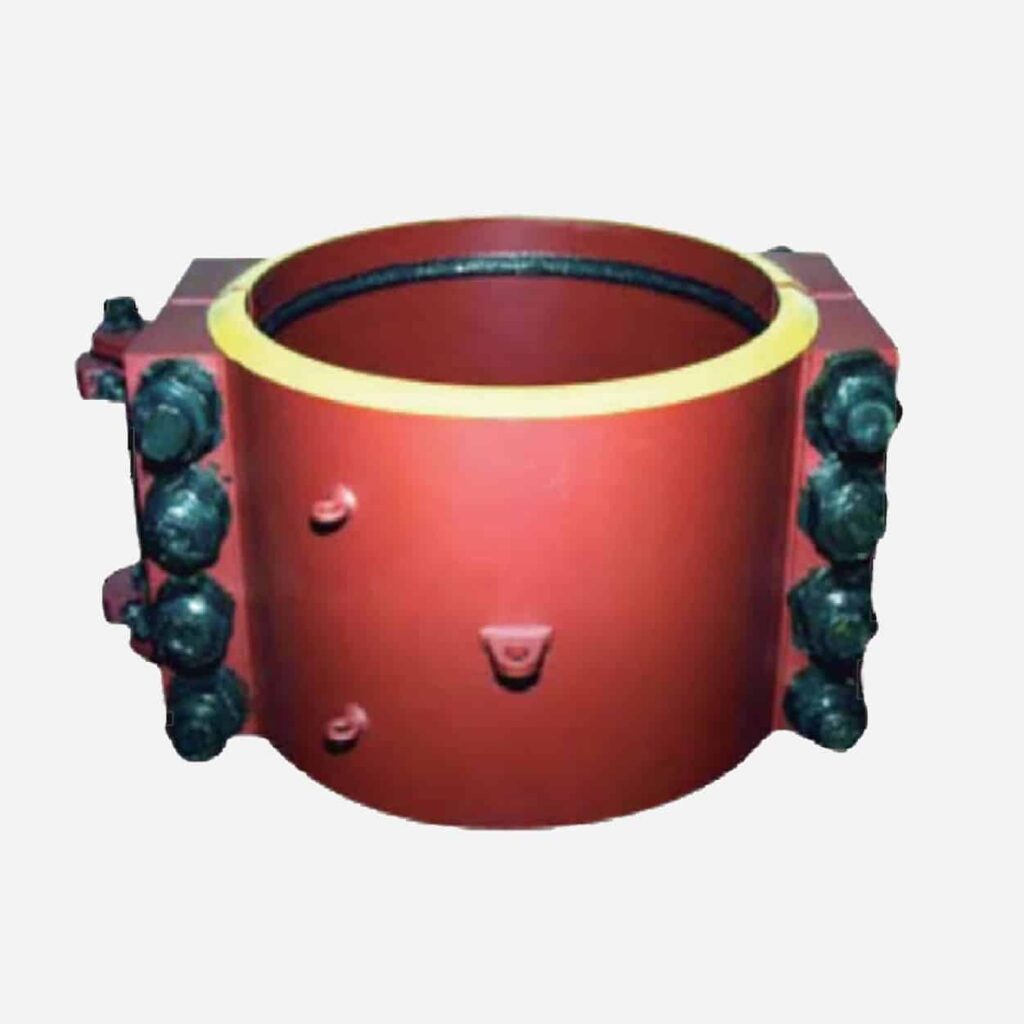
High pressure pipe repair coupling , can withstand max. pressure is 8 Mpa
Sr No. SSPC009
● MATERIAL Cast Steel
● FUNCTION
This pipe repair coupling is specifically designed for repairing high-pressure pipelines, can withstand max. pressure is 8 MPa.
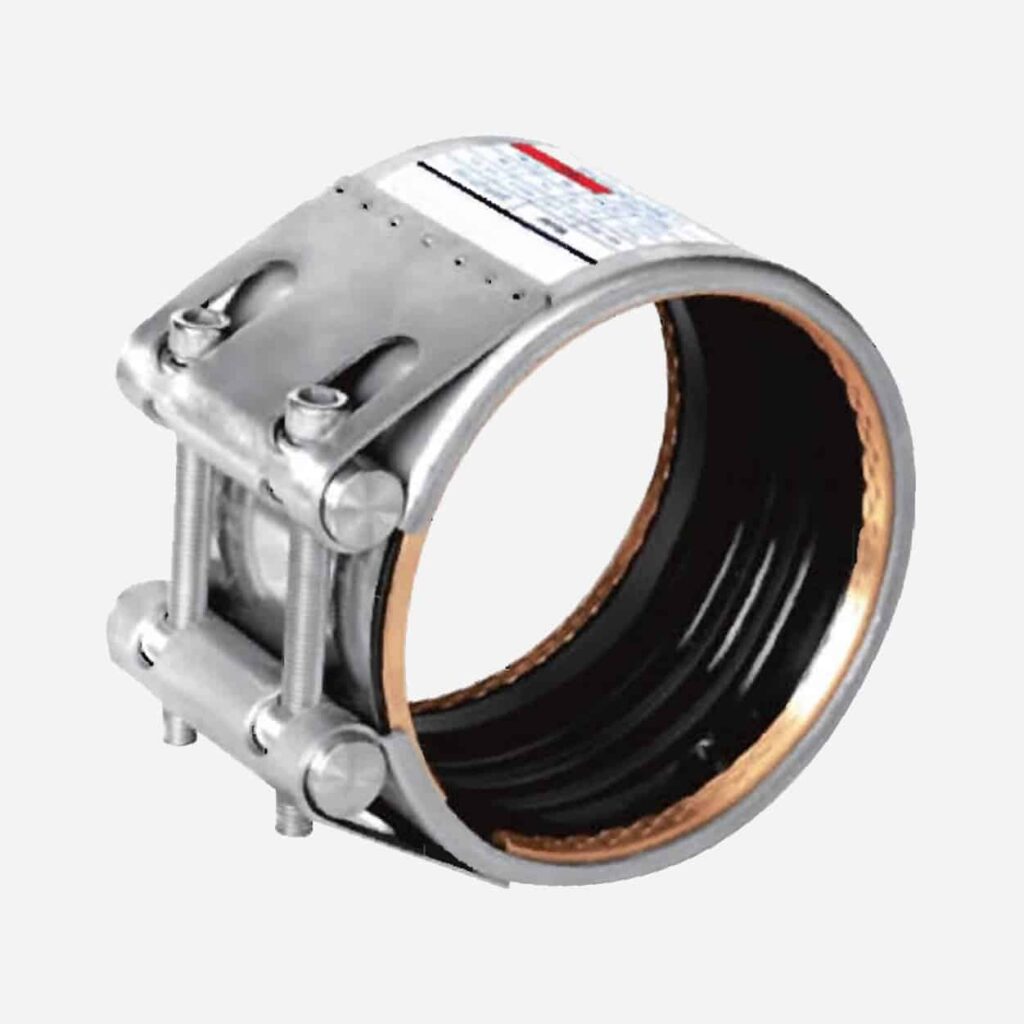
Restrained pipe coupling adapter for HDPE pipes, with grip ring to avoid pipes to be pulled out
Sr No. SSPC010
● MATERIAL
Stainless Steel band and brass grip ring
● FUNCTION
The enhanced pipe coupling, compared to the standard pipe coupling, offers superior impact resistance and a reliable axial pull-out resistance function. The maximum pressure can reach 70 bar (7 MPa).
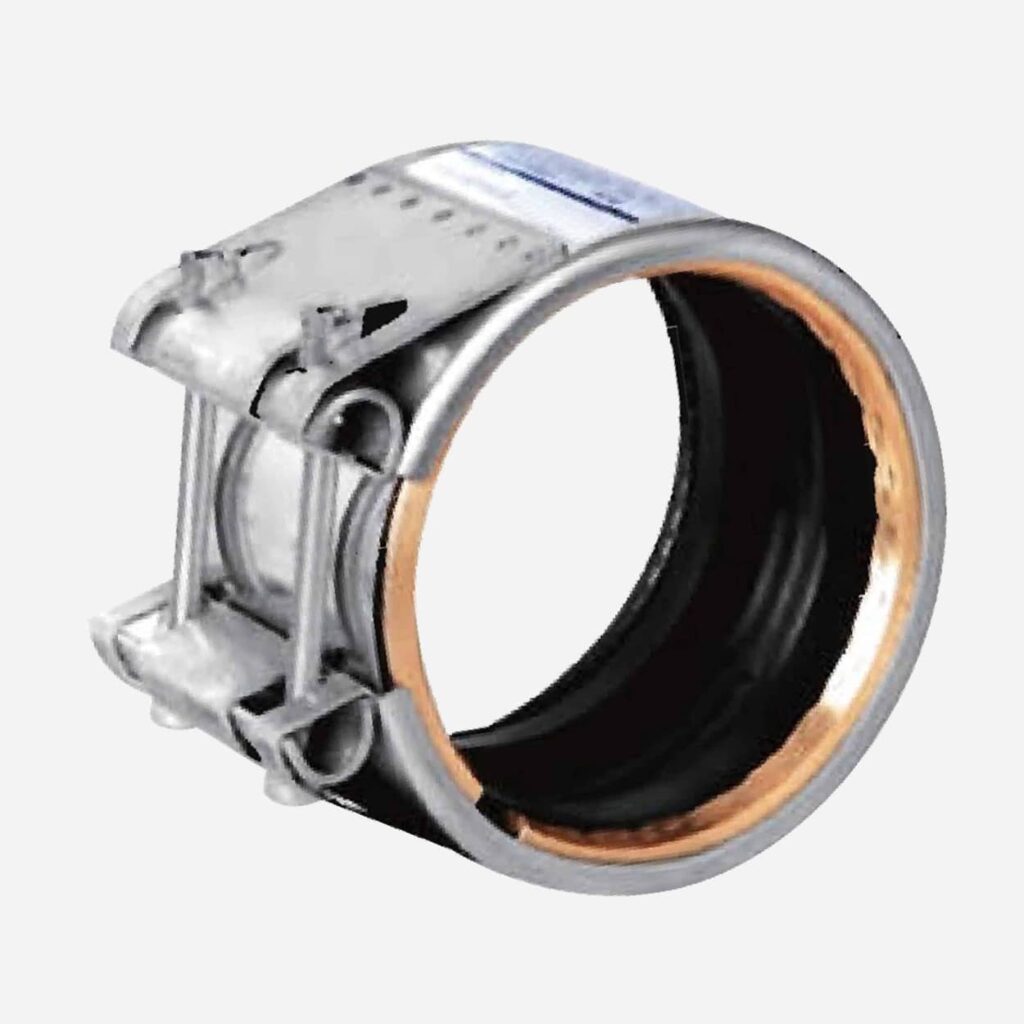
One end restrained , another end non restrained pipe coupling
Sr No. SSPC011
● MATERIAL
Stainless Steel band and brass grip ring
● FUNCTION
One end with grip ring to connect HDPE pipes which is easily to be deformed to avoid leakage, another ends without grip ring to connect ductile iron, steel etc pipes which is not easily to be deformed
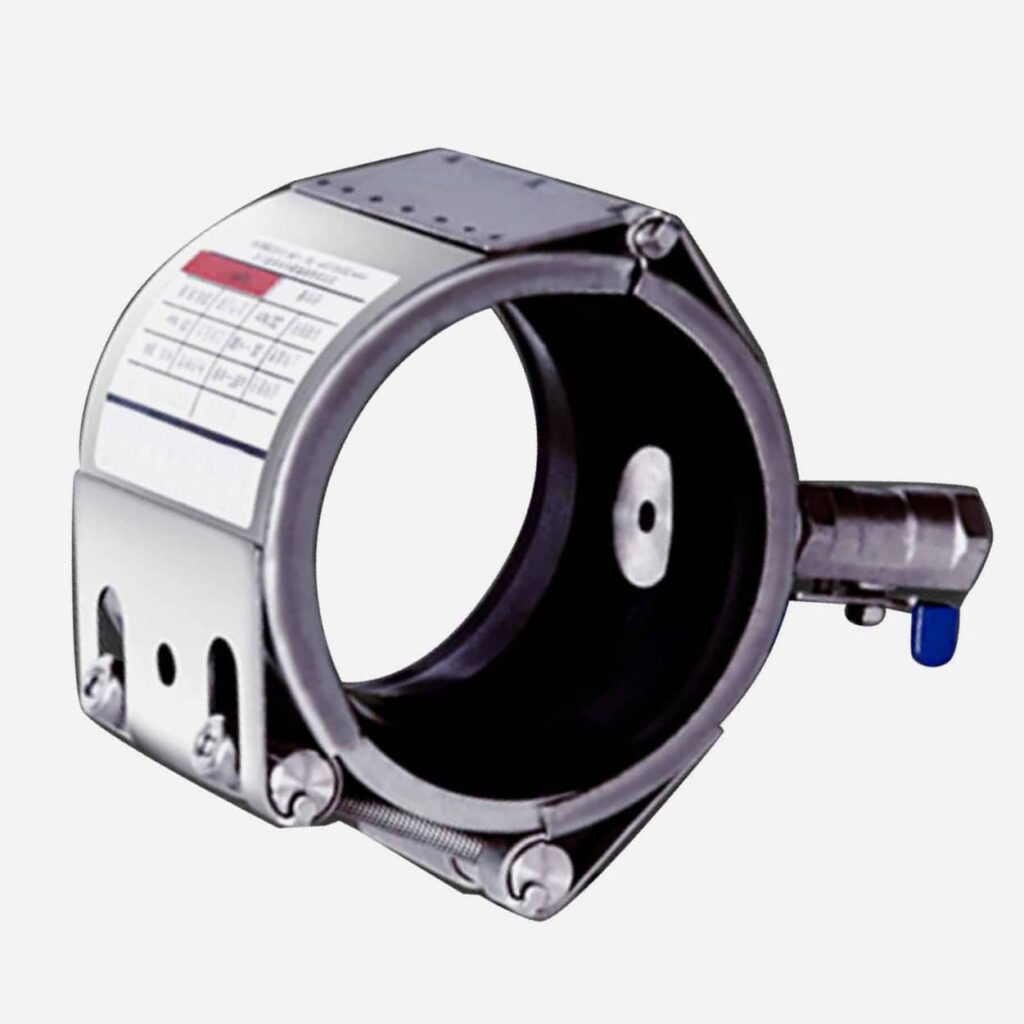
Pipe coupling with branch outlet ,branch outlet can be customized
Sr No. SSPC015
● MATERIAL Stainless Steel
● FUNCTION
Pipe coupling with outlet, outlet can be thread outlet, flange outlet etc, also can be with isolation valve for the control of on-off of the branch pipeline.
STAINLESS STEEL PIPE COUPLING
The stainless steel pipe coupling can be used for pipeline connections, and some designs combine the functions of a pipe coupling and a repair clamp.
The stainless steel pipe coupling allows for a certain degree of axial movement and angular deflection of the pipe.
It features a self-sealing structure, where the sealing performance improves as the pressure increases.
Stainless steel pipe coupling with anchor rings to avoid pipes to be pulled out, axially restrained
Sr No. SSPC001
● MATERIAL Stainless Steel
● FUNCTION
Connect pipes, this pipe coupling have two grip rings on both ends to grip pipes, can replace flange ,welding, groove and thread etc connection, quick and easy
stainless steel pipe coupling for pipe connection which allow for pipe expansion and contraction
Sr No. SSPC002
● MATERIAL Stainless Steel
● FUNCTION
Connect pipes, This pipe coupling is designed with thick sealing lips on both ends. When the pipeline expands or contracts due to temperature changes or external forces, the thick sealing lips effectively provide a tight seal to prevent leakage.
Stainless steel pipe coupling with anchor rings to avoid pipes to be pulled out, axially restrained, narrow type for limited space
Sr No. SSPC003
● MATERIAL Stainless Steel
● FUNCTION
Connect pipes, this pipe coupling have two grip rings on both ends to grip pipes, can replace flange ,welding, groove and thread etc connection, quick and easy, narrow type for limited space

Single band stainless steel pipe repair coupling for permanent repair with pressure in pipeline
Sr No. SSPC004
● MATERIAL Stainless Steel
● FUNCTION
Open the repair coupling, wrap it around the pipe and fasten the tie rods, then you can repair the pipe with pressure inside the pipeline

Double bands stainless steel pipe repair coupling for permanent repair with pressure in pipeline
Sr No. SSPC005
● MATERIAL Stainless Steel
● FUNCTION
Open the repair coupling, wrap it around the pipe and fasten the tie rods, then you can repair the pipe with pressure inside the pipeline

Heavy duty stainless steel pipe coupling for more impact resistance and axial pull-out resistance
Sr No. SSPC006
● MATERIAL Stainless Steel
● FUNCTION
The enhanced pipe coupling, compared to the standard pipe coupling, offers superior impact resistance and a reliable axial pull-out resistance function. The maximum pressure can reach 70 bar (7 MPa).

Stainless steel Fire-resistant pipe coupling
Sr No. SSPC007
● MATERIAL Stainless Steel
● FUNCTION
Fire-resistant pipe coupling, suitable for connecting metal pipes of all wall thicknesses, with axial pull-out resistance. It is a high-security fire-protected mechanical pipe coupling. Under high temperatures of +800°C (±50°C), it can provide fire resistance for up to 90 minutes.

Single band stainless steel pipe repair coupling for permanent repair with pressure in pipeline
Sr No. SSPC008
● MATERIAL Stainless Steel
● FUNCTION
Pipe coupling with tie rods, suitable for pipes made of any material, featuring axial limiting and compensation functions. The combination of limiting tie rods and the pipe coupling allows it to not only serve as a pipe coupling for connection but also provide vibration damping and noise reduction functions similar to those of an expansion joint.

High pressure pipe repair coupling , can withstand max. pressure is 8 Mpa
Sr No. SSPC009
● MATERIAL Cast Steel
● FUNCTION
This pipe repair coupling is specifically designed for repairing high-pressure pipelines, can withstand max. pressure is 8 MPa.

Restrained pipe coupling adapter for HDPE pipes, with grip ring to avoid pipes to be pulled out
Sr No. SSPC010
● MATERIAL
Stainless Steel band and brass grip ring
● FUNCTION
The enhanced pipe coupling, compared to the standard pipe coupling, offers superior impact resistance and a reliable axial pull-out resistance function. The maximum pressure can reach 70 bar (7 MPa).

One end restrained , another end non restrained pipe coupling
Sr No. SSPC011
● MATERIAL
Stainless Steel band and brass grip ring
● FUNCTION
One end with grip ring to connect HDPE pipes which is easily to be deformed to avoid leakage, another ends without grip ring to connect ductile iron, steel etc pipes which is not easily to be deformed

Pipe coupling with branch outlet ,branch outlet can be customized
Sr No. SSPC015
● MATERIAL Stainless Steel
● FUNCTION
Pipe coupling with outlet, outlet can be thread outlet, flange outlet etc, also can be with isolation valve for the control of on-off of the branch pipeline.
PIPE COUPLING TYPES
By material
Pipe couplings can be made of many materials,
common materials are cast iron (include ductile iron and grey cast iron), steel (include carbon steel and stainless steel), PVC, PP, PE, FRP, Brass and copper.
CAST IRON COUPLINGS
_
Cast iron couplings have high strength to withstand high pressure, strong and wear-resistant , corrosion resistance, heat resistance, stable dimensions , good sealing performance, low price, fast and simple production, so it is widely used in water supply, sewage, oil and other pipelines, can be used to connect Ductile iron, PVC, HDPE, Steel, AC, GRP etc most pipes.
STEEL PIPE COUPLINGS
_
Steel pipe couplings have high tensile strength and hardness, suitable for high-pressure and high-temperature environments. It has lower ductility compared to ductile iron pipe coupling but provides higher strength in structural applications. Therefore, it is widely used in petroleum and natural gas, chemical processing, power generation, and industrial pipeline systems. It is suitable for high-pressure, high-temperature environments, and applications that require high mechanical strength.
PVC COUPLING
_
Made of polyvinyl chloride (PVC), low cost, lightweight, and corrosion-resistant.Typically used in low-pressure and non-high-temperature environments.However, compared to metal pipe couplings, PVC couplings have lower strength and are not suitable for high-pressure or high-temperature applications. They are prone to failure under extreme conditions. They have poor UV resistance and can age and become brittle when exposed to sunlight for long periods.mainly used in water supply and drainage systems, irrigation systems, and chemical pipelines.
PP COUPLING
_
Is corrosion resistance, lightweight, good temperature resistance, wear resistance, ease of installation, and non-toxic, so it is widely used in the chemical, water treatment, agricultural irrigation, food and beverage, pharmaceutical, cooling systems, and electronics industries . In these areas, PP couplings provide an economical, efficient, and reliable solution for pipe connections.
PE COUPLING
_
Is widely used in the water supply, drainage, natural gas transmission, agricultural irrigation, industrial transportation, communication cable sheathing, and ground source heat pump systems because of its corrosion resistance, lightweight, good flexibility, low-temperature resistance, non-toxic and environmentally friendly properties. However, its low temperature resistance and strength, as well as its sensitivity to ultraviolet light, are its main disadvantages. In the appropriate application scenario, PE couplings provide an economical, efficient, and reliable solution for pipe connections.
FRP COUPLINGS
_
Are widely used in the chemical, marine engineering, oil and gas, municipal water supply and drainage, power, food and pharmaceutical industries due to their high strength, lightweight, corrosion resistance, temperature resistance, insulation, and aging resistance. However, the disadvantages of its high cost, lower mechanical properties than metal, complex connection, and large thermal expansion coefficient need to be considered in design and use. In the appropriate application scenario, FRP pipe couplings provide a long-lasting and reliable solution for pipe connections.
BRASS PIPE COUPLINGS
_
Are widely used in water supply, gas supply, air conditioning and refrigeration, industrial equipment, ships, sanitary equipment, and electrical connections due to their corrosion resistance, high strength, high and low temperature resistance, wear resistance, antibacterial properties, and conductivity and thermal conductivity. However, the disadvantages of its high cost, heavy weight, and possible lead content need to be considered in design and use. In the appropriate application scenario, brass pipe couplings provide a reliable and durable connection solution.
COPPER PIPE COUPLINGS
_
Are widely used in water supply, HVAC, gas transmission, medical equipment, industrial equipment, electrical equipment, and solar and geothermal systems due to their excellent corrosion resistance, high strength, good thermal and electrical conductivity, antibacterial properties, flexibility, and high-temperature resistance. However, the disadvantages of its high cost, heavy weight, and ease of theft need to be considered in some applications.
BY FUNCTION
● FUNCTION
Allows the pipe to move axially, radially, and angularly within a certain range to accommodate thermal expansion, foundation settlement, and vibration.
● APPLICATION
Used for building water supply systems, industrial pipeline systems, and pipeline connections in earthquake-prone areas.
2. Rigid Pipe Coupling
_
● FUNCTION
Provides a strong, fixed connection that does not allow for any movement, ensuring the rigidity of the pipe system.
● APPLICATION
Used for pipe systems that do not require movement or expansion, such as fixed conveyance pipes and structural pipes.
3. EXPANSION JOINT
_
● FUNCTION
Absorbs and reduces vibration and noise in the pipe system, protecting pipes and their connecting equipment. Allows for the expansion and contraction of pipes due to temperature changes, preventing pipe deformation or rupture.
● APPLICATION
Commonly used in mechanical equipment connections, pump rooms, and compressor pipe systems.
4. STEP COUPLING
_
● FUNCTION
Connects pipes of different diameters, providing a transition from larger diameters to smaller diameters.
● APPLICATION
Used in various systems that require connecting pipes of different sizes, such as water systems.
5. Quick Coupling
_
● FUNCTION
Allows for the quick connection and disconnection of pipes, easy to operate, and typically does not require tools.
● APPLICATION
Widely used in pipe systems that require frequent disassembly and replacement, such as hydraulic systems and laboratory equipment.
6. Flanged Pipe Coupling
_
● FUNCTION
Connects pipes using flanges and bolts, providing a strong, reliable connection that is easy to disassemble and maintain.
● APPLICATION
Used in large diameter pipes, industrial pipelines, and municipal pipeline systems.
7. Threaded Pipe Coupling
_
● FUNCTION
Connects pipes using threads, easy to install and disassemble, suitable for small diameter pipes.
● APPLICATION
Used in home water supply, gas pipelines, and small industrial pipeline systems.
8. Welded Pipe Coupling
_
● FUNCTION
Permanently connects pipes by welding, providing a high-strength and leak-proof connection.
● APPLICATION
Used in high-pressure, high-temperature, and critical process pipe systems.
9. Slip Pipe Coupling
_
● FUNCTION
Allows the pipe to slide inside the coupling to accommodate a certain length change, typically used for repairing pipes.
● APPLICATION
Used in pipe systems that require length adjustment or temporary repairs.
These pipe couplings with different functions are widely used in various pipe systems to meet different engineering requirements and
applications based on their specific designs and functions.
BY PIPELINE
TYPE
● Flexible coupling: Adaptable to minor pipe displacement and vibration.
● Repair coupling: Used to repair and adjust pipe lengths.
● Step coupling: Connects pipes of different diameters or different materials.
● Flanged coupling: Connects flange to pipe plain ends, normally for large-diameter drainage pipes.
● Application: Used in residential, commercial, and industrial building water supply pipe systems to ensure the safe delivery of water.
DRAINAGE
PIPE COUPLING
_
TYPE
● Flexible coupling: Adaptable to foundation settlement and ground movement.
● Repair coupling: Used to repair and adjust pipe lengths.
● Flanged coupling: Connects flange to pipe plain ends, normally for large-diameter drainage pipes.
● Application: Used in urban drainage, sewage treatment systems, and stormwater discharge systems.
GAS
PIPE COUPLING
_
TYPE
● Threaded pipe coupling: Provides a tight connection to prevent leaks.
● Welded pipe coupling: For the permanent connection of high-pressure gas pipes.
● Quick coupling: For quick disconnection in emergencies.
● Application: Used for the transportation of natural gas and liquefied petroleum gas (LPG) pipeline systems.
HVAC
PIPE COUPLING
_
TYPE
● Flexible coupling: Adaptable to thermal expansion and contraction.
● Flanged pipe coupling: Connects pipes in large air conditioning systems.
● Welded pipe coupling: For high-temperature and high-pressure HVAC pipes.
● Application: Used for the delivery of hot and cold water and refrigerants in air conditioning, refrigeration, and heating systems.
INDUSTRIAL
PIPE COUPLING
_
TYPE
● Corrosion-resistant coupling: For the transport of corrosive media in chemical plants.
● High-pressure coupling: For high-pressure steam and liquid pipelines.
● Shock-absorbing coupling: Reduces the impact of mechanical vibrations on the pipes.
● Application: Used in various industrial pipeline systems in chemical, petroleum, natural gas, metallurgy, and manufacturing industries.
TYPE
● Flanged pipe coupling: Ensures the strength and stability of the pipe system.
● Flexible coupling: Adaptable to thermal expansion and contraction and vibrations in buildings.
● Quick coupling: For quick installation and disassembly.
● Application: Used in fire protection water pipe systems in buildings and industrial facilities.
AGRICULTURAL IRRIGATION
PIPE COUPLING
_
TYPE
● Slip pipe coupling: For adjusting the length of irrigation systems.
● Flexible coupling: Adaptable to changes in terrain.
● Quick coupling: For quick connection and disconnection.
● Application: Used in farmland and horticultural irrigation systems to ensure the efficient delivery of water.
FOOD AND PHARMACEUTICAL
PIPE COUPLING
_
TYPE
●Stainless steel coupling: Ensures pollution-free and corrosion-resistant properties.
● Quick coupling: For frequent cleaning and maintenance.
● Sterile coupling: Ensures the sanitary and safe transport of media.
● Application: Used in liquid and gas transport systems in the food processing and pharmaceutical industries.
OIL AND
GAS PIPE COUPLING
_
TYPE
●High-pressure coupling: For high-pressure transport.
Explosion-proof coupling: Ensures safety.
● Corrosion-resistant coupling: For marine environments.
● Application: Used in pipeline systems for the exploration, transport, and storage of oil and natural gas.
TYPE
● Corrosion-resistant coupling: For seawater pipe systems.
● Flexible coupling: Adaptable to the movement of ships and offshore platforms.
● High-pressure coupling: For ship power systems and marine engineering.
● Application: Used in water, fuel, and wastewater pipe systems in ships and marine engineering.
These pipe couplings with different functions and application scenarios ensure that the pipe systems operate efficiently, safely, and reliably based on their specific designs and performance requirements.
RFQ
Pipe Coupling design standard:AWWA C219; EN545; AS/NZS2280
Pipe Coupling Angular Deflection:The maximum allowable deflection angle of a pipe within a pipe coupling decreases as the nominal pipe size increases, because for larger pipe diameters, the same deflection angle results in a greater displacement of the pipe (as shown in the figure below). For the same nominal pipe size, the longer the center-sleeve length, the greater the maximum allowable deflection angle.


